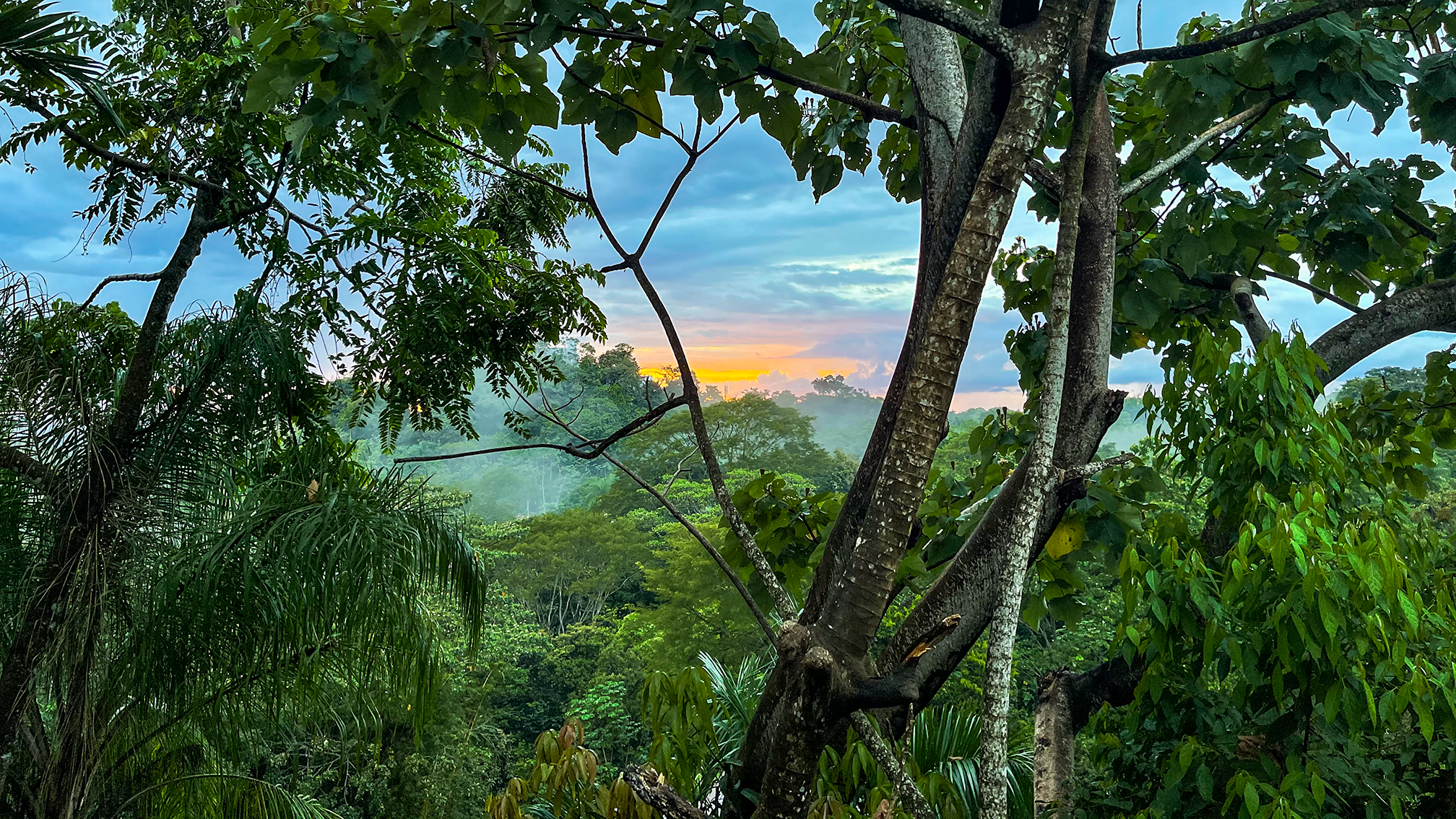
Our love for wildlife photography is just evolving. I love landscapes and cityscapes and always felt that wildlife was difficult to capture but as we exlpored new regions and countries
we started to find immense joy in trying to photograph the wildlife of places we visited. They are difficult to capture, require a lot of patience and they are not predictable.
But they have made us admire a completely different aspect of our trips. The one where we need to slow down, be in the moment, just listen and do things without any regrets. We were really encouraged with what we were able to capture in Patagonia and the passion developed from there.
This is a growing collection of birds, animals and a few other curiosities that filled our lenses and hearts.
Hopefully we will be able to grow this library over time.
Click on the images to learn more about these fascinating creatures and where we found them. Click again to close and come
back to the gallery.
Bird names are linked to their respective profile page on e-Bird which is a fantastic resource from Cornell University for bird enthusiasts.
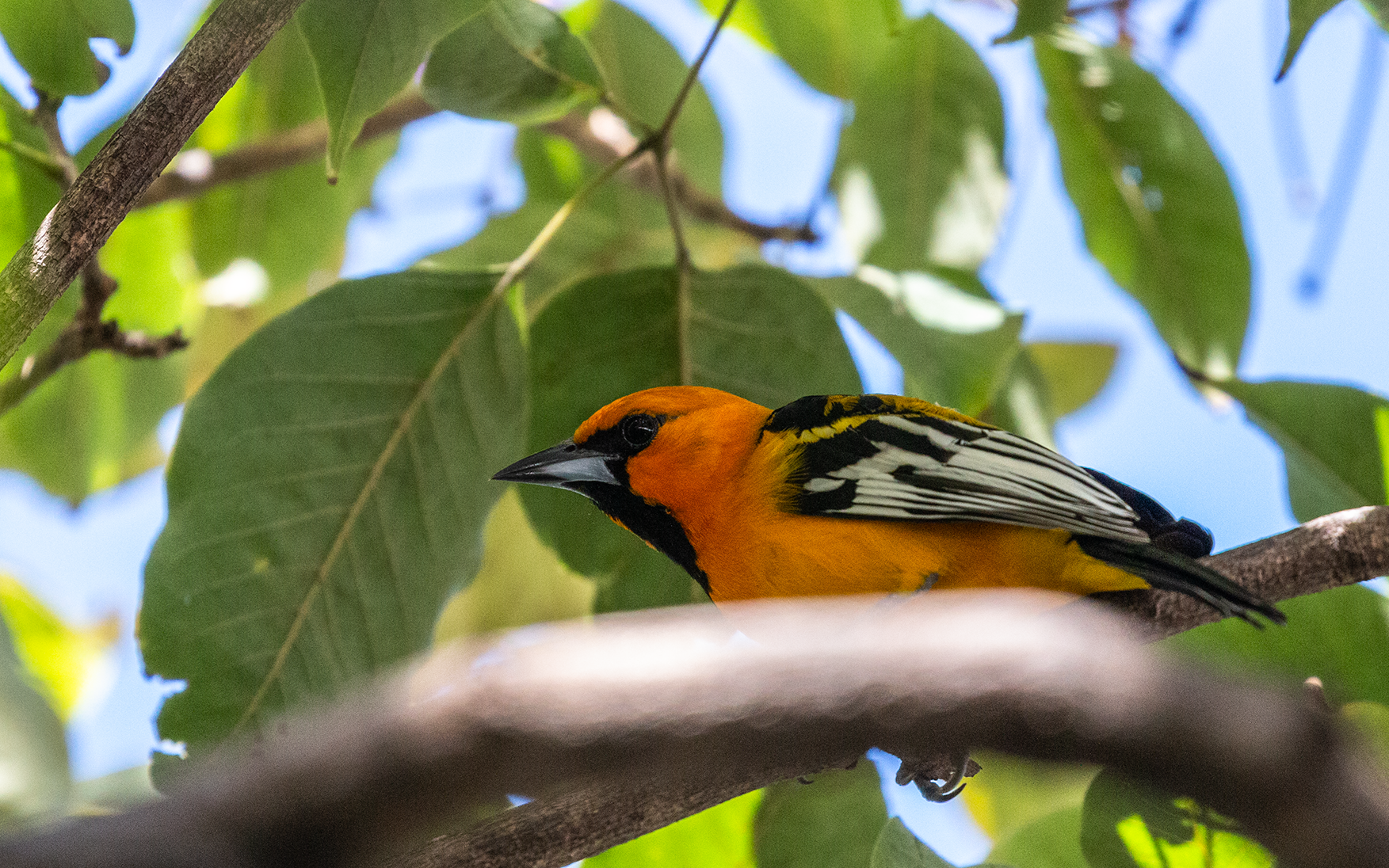
Quite common and conspicuous in lowlands in northern South America, where it resides in open woodlands, second growth, and gardens. Typical plumage pattern for an oriole, but more yellow and less black than other species. Especially note yellow back and limited black mask and bib.
COSTA RICA . 2020
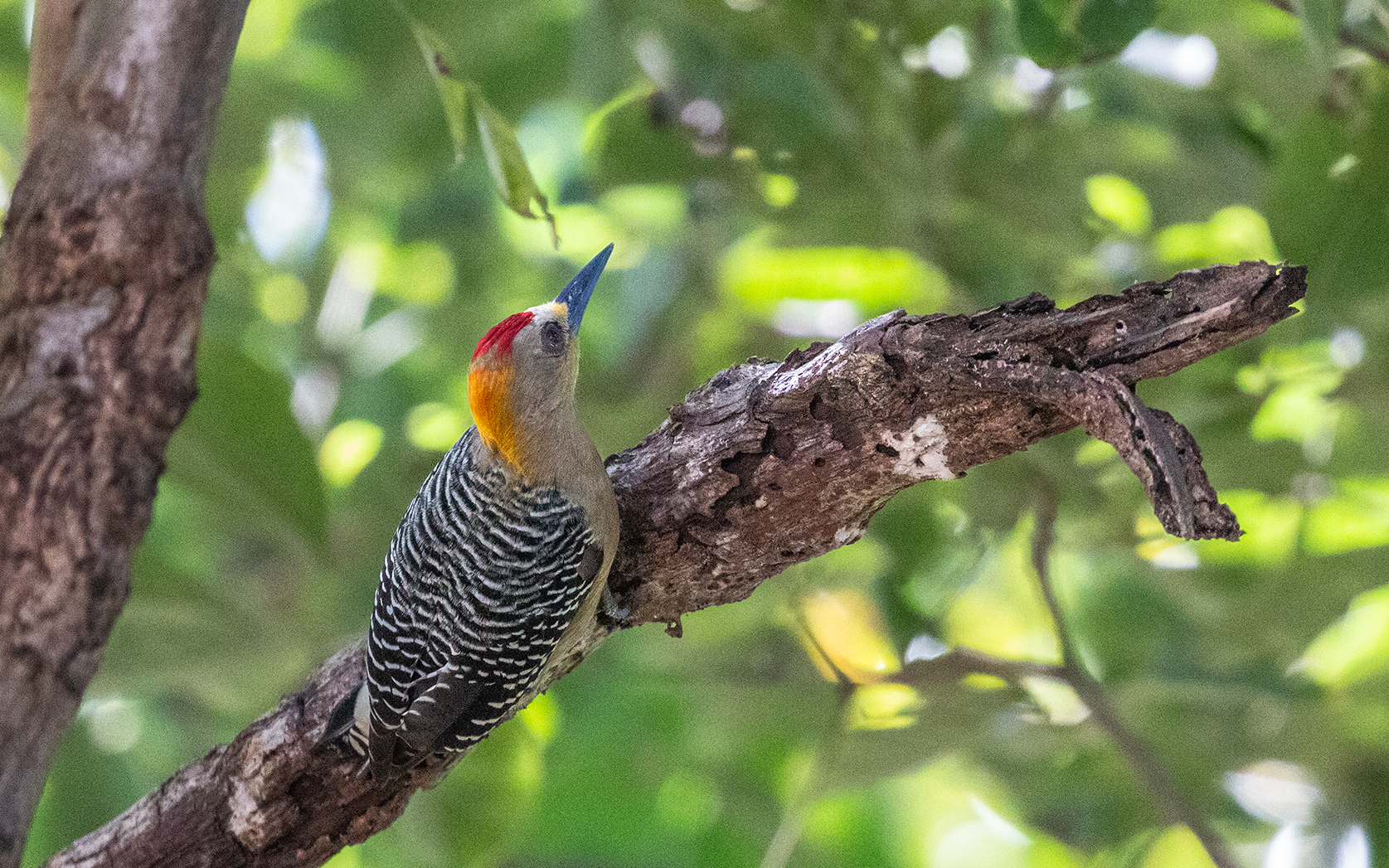
Medium-sized woodpecker found from Costa Rica to northern South America. Pale buffy overall with a red nape and belly and black-and-white barring on the back. Female has a pale crown with restricted red on the back of the nape; male has red extending to top of crown. Common in open woodlands, second growth, and gardens.
COSTA RICA . 2020
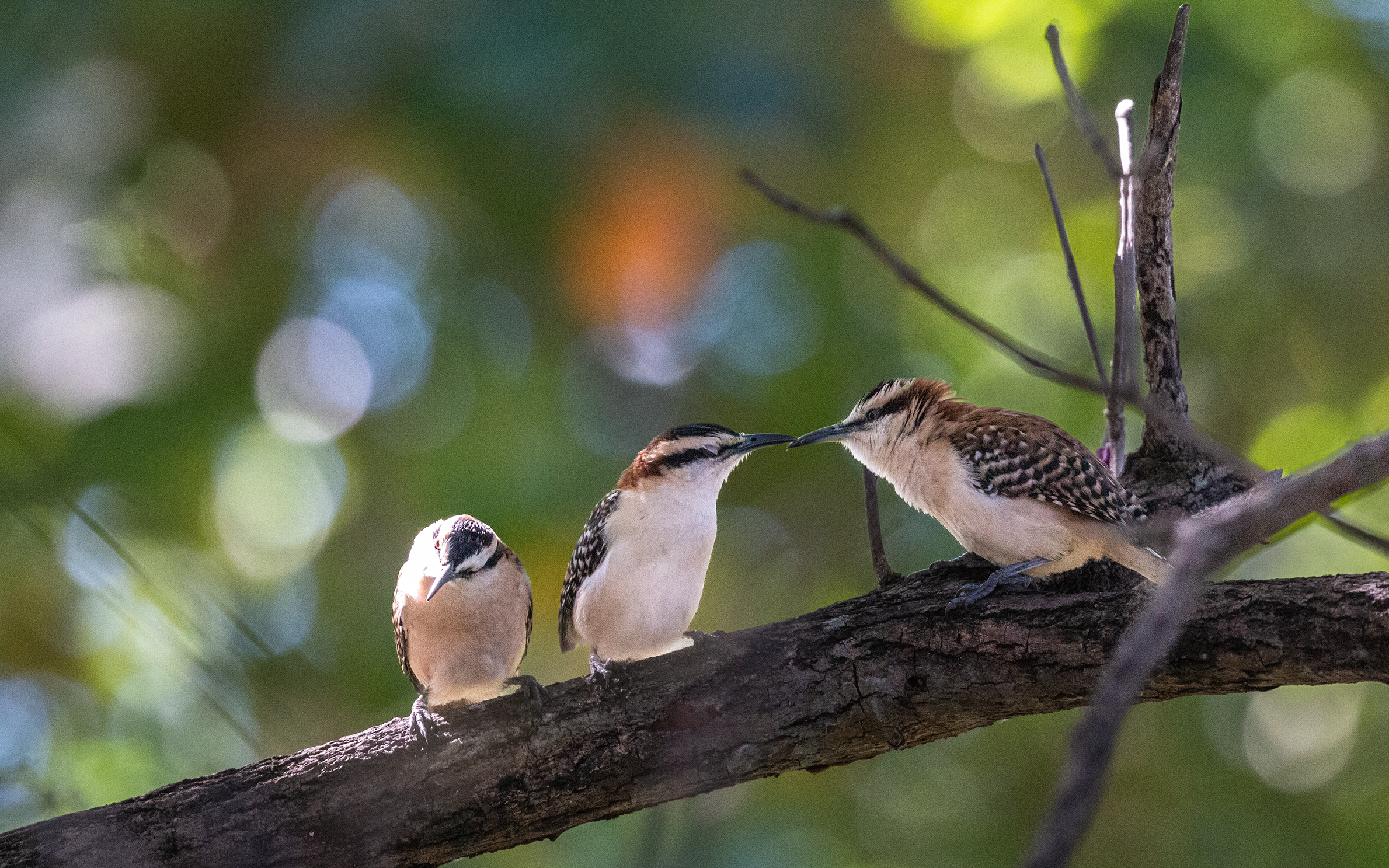
Widespread but often local large wren with pronounced geographic variation in appearance. Usually in small groups, less often in pairs. Mainly found in thorn forest and dry scrubby habitats, but also (rufous-backed form) in more humid scrub and semiopen areas on coastal slope of Chiapas where can be confused with Giant Wren.
COSTA RICA . 2020
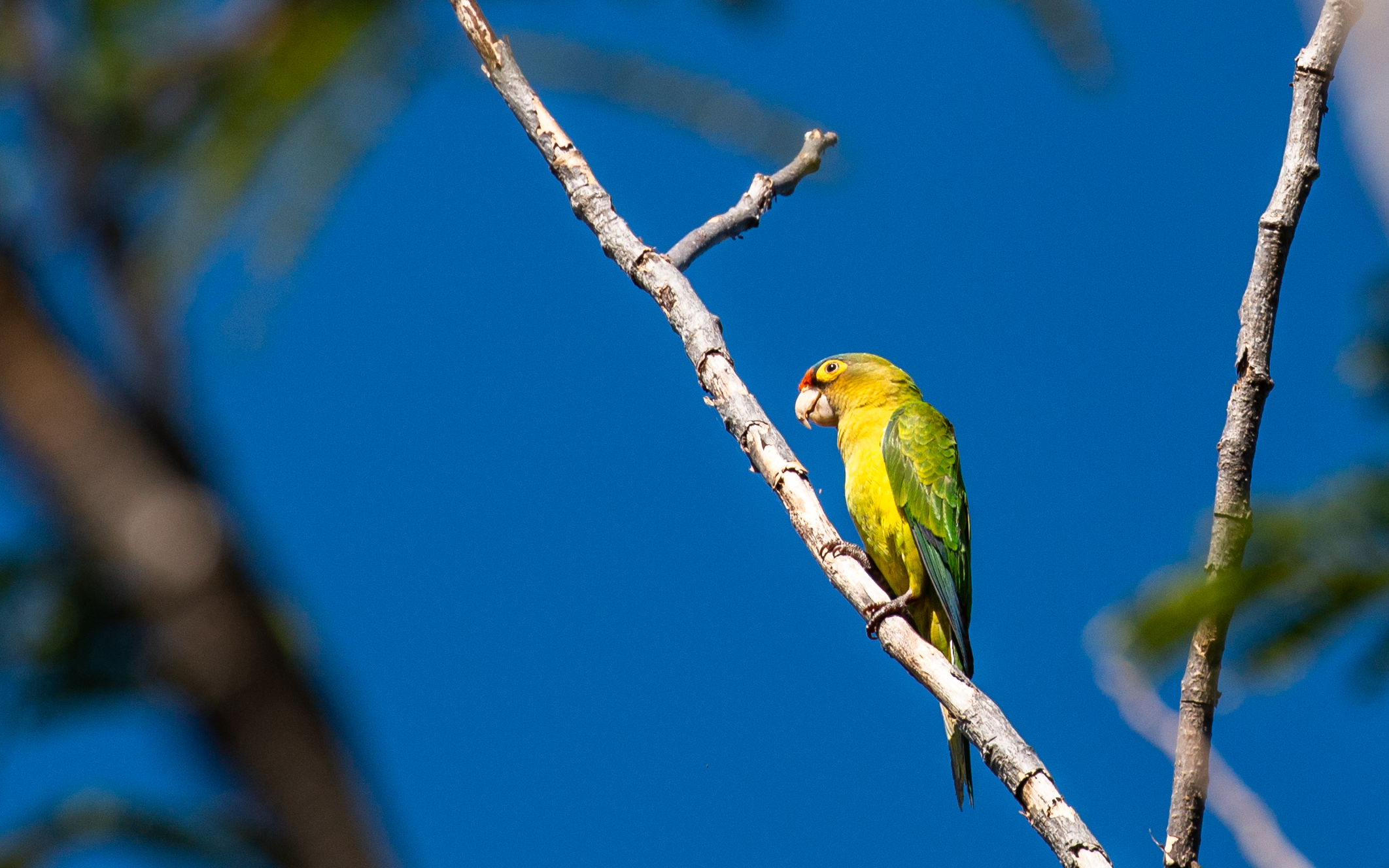
Parakeets are fairly small parrots, usually with a relatively long and somewhat pointed tail. This species is fairly common in tropical lowlands, mainly in semiopen areas with scattered trees, woodlands, and locally in towns and suburban areas. Often in small flocks or in pairs. Note the bright orange forehead and yellowish eyering. In most parts of its range, no other parakeets occur.
COSTA RICA . 2020
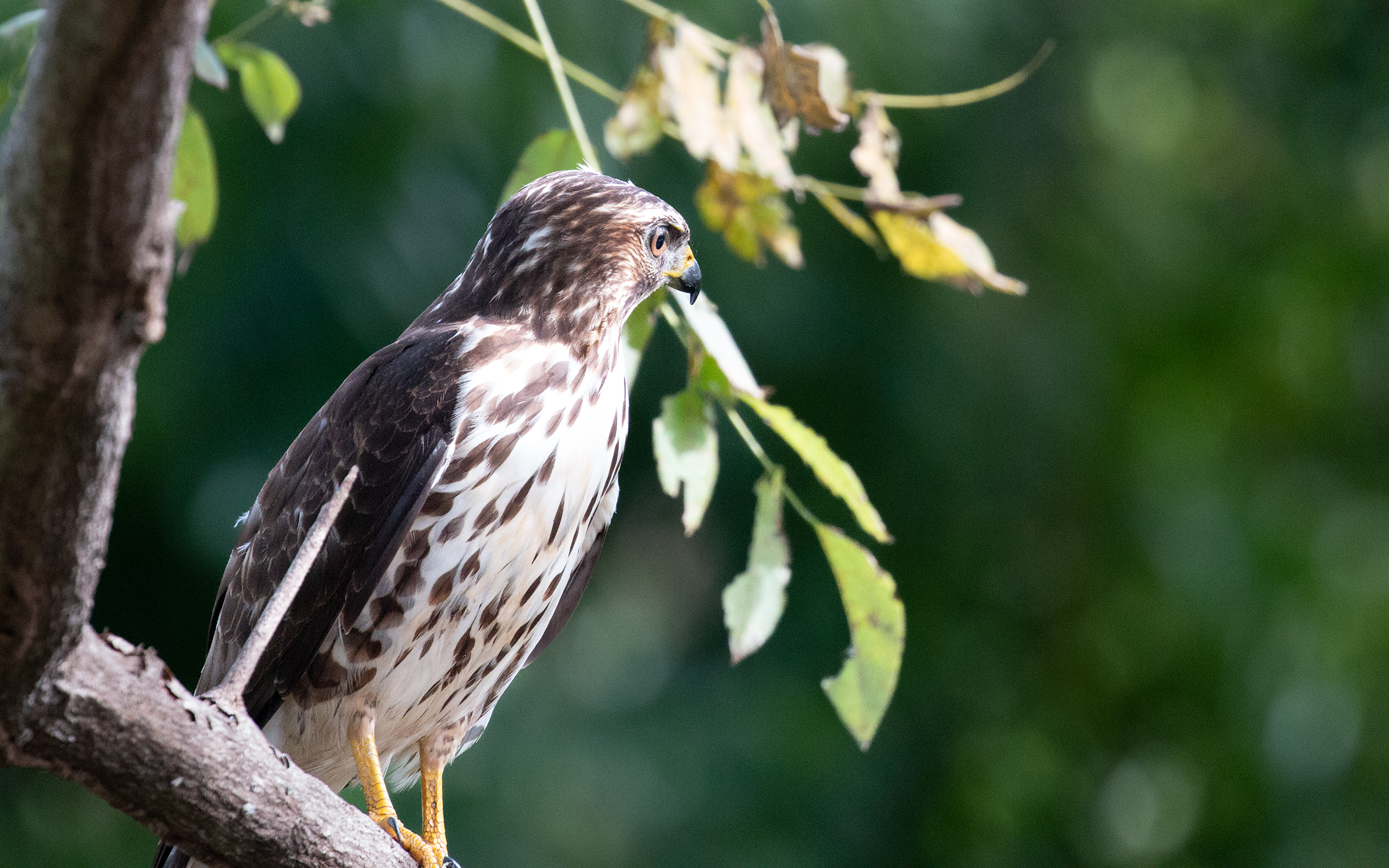
Rather small, compact hawk; about the size of Red-shouldered Hawk, smaller than Red-tailed Hawk. Adults are solid brown above, barred reddish-brown below with bold black-and-white tail bands. Immatures similar, but with blotchier markings below and thin, diffuse tail bands. Distinctive shape in flight: note the short tail, straight leading edge of wing, and bulging secondaries in flight.
COSTA RICA . 2020
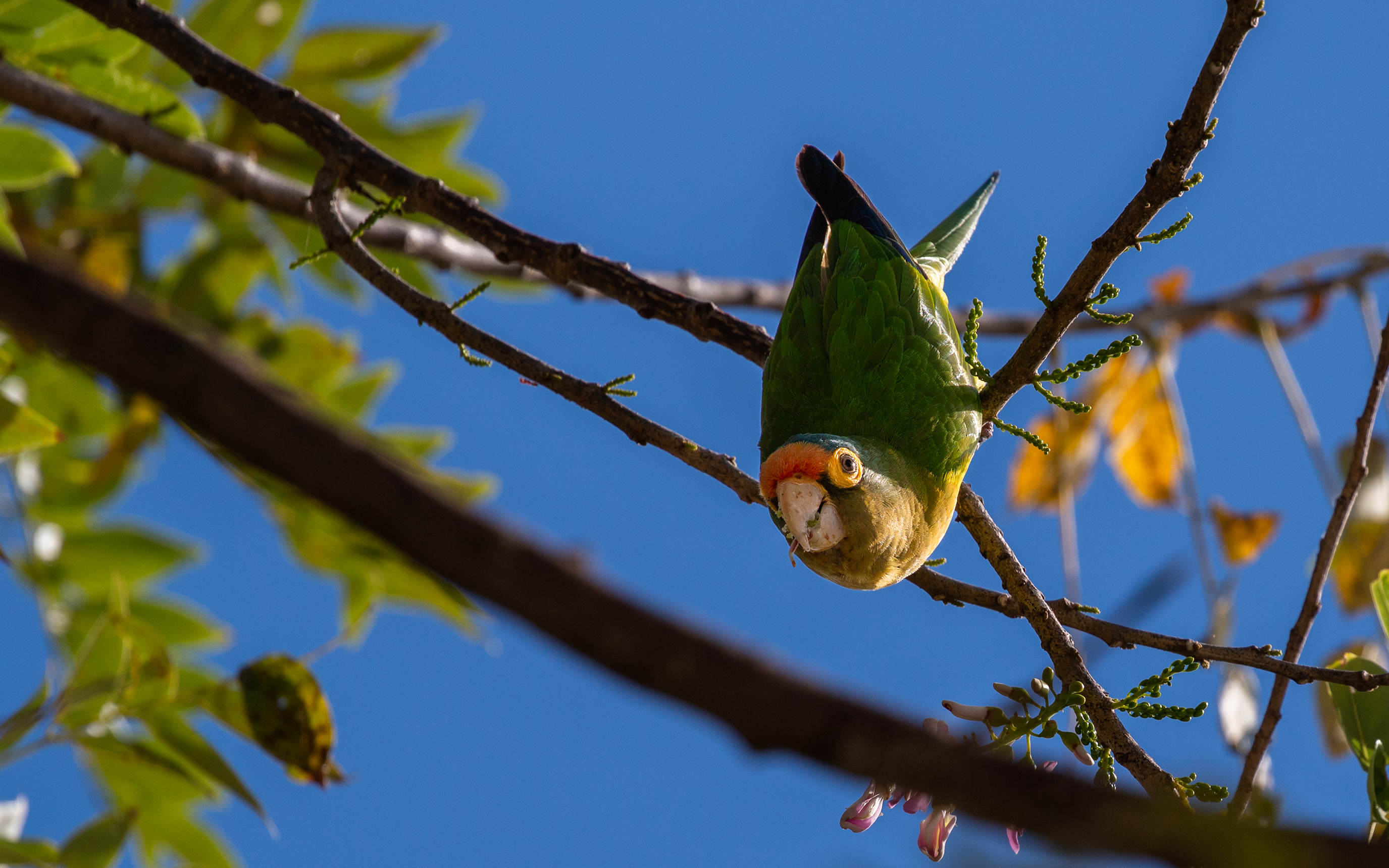
Parakeets are fairly small parrots, usually with a relatively long and somewhat pointed tail. This species is fairly common in tropical lowlands, mainly in semiopen areas with scattered trees, woodlands, and locally in towns and suburban areas. Often in small flocks or in pairs. Note the bright orange forehead and yellowish eyering. In most parts of its range, no other parakeets occur.
COSTA RICA . 2020
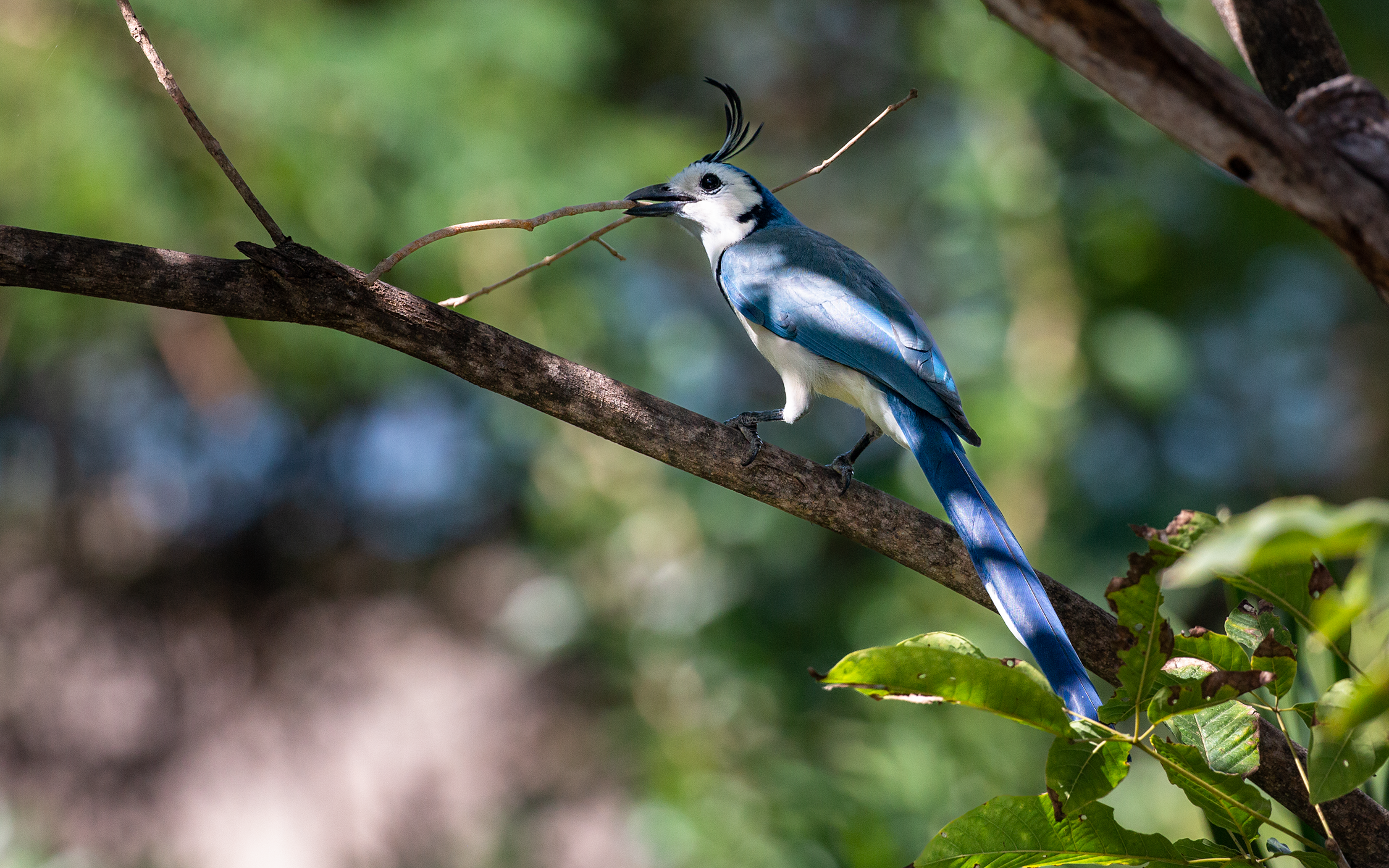
Spectacular, large, and often conspicuous jay of tropical lowland forests, plantations, and semiopen areas with hedges and tall trees; prefers drier areas, but locally in rather humid situations. Usually in small groups and can be surprisingly inconspicuous if feeding quietly.
COSTA RICA . 2020
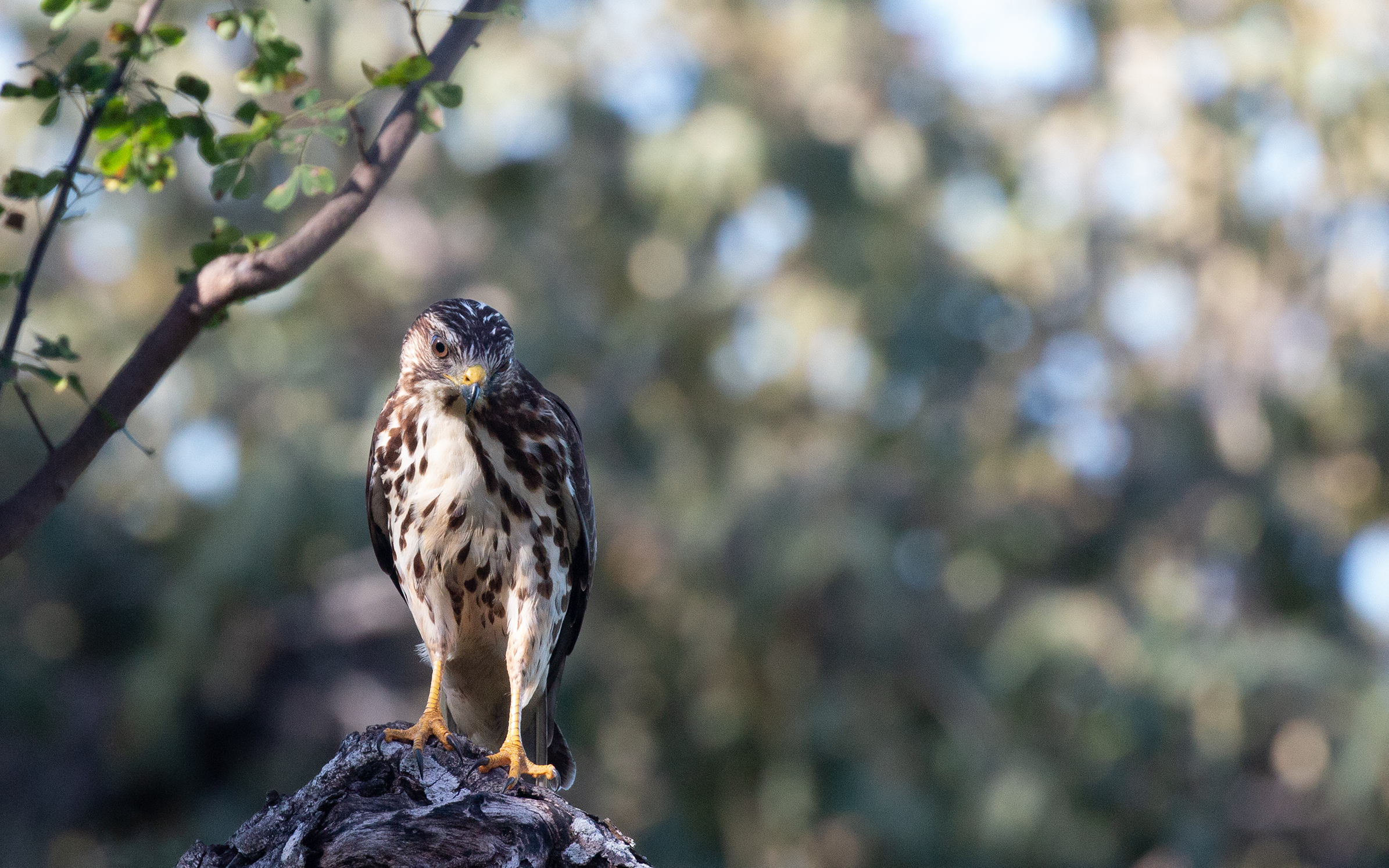
Rather small, compact hawk; about the size of Red-shouldered Hawk, smaller than Red-tailed Hawk. Adults are solid brown above, barred reddish-brown below with bold black-and-white tail bands. Immatures similar, but with blotchier markings below and thin, diffuse tail bands. Distinctive shape in flight: note the short tail, straight leading edge of wing, and bulging secondaries in flight.
COSTA RICA . 2020
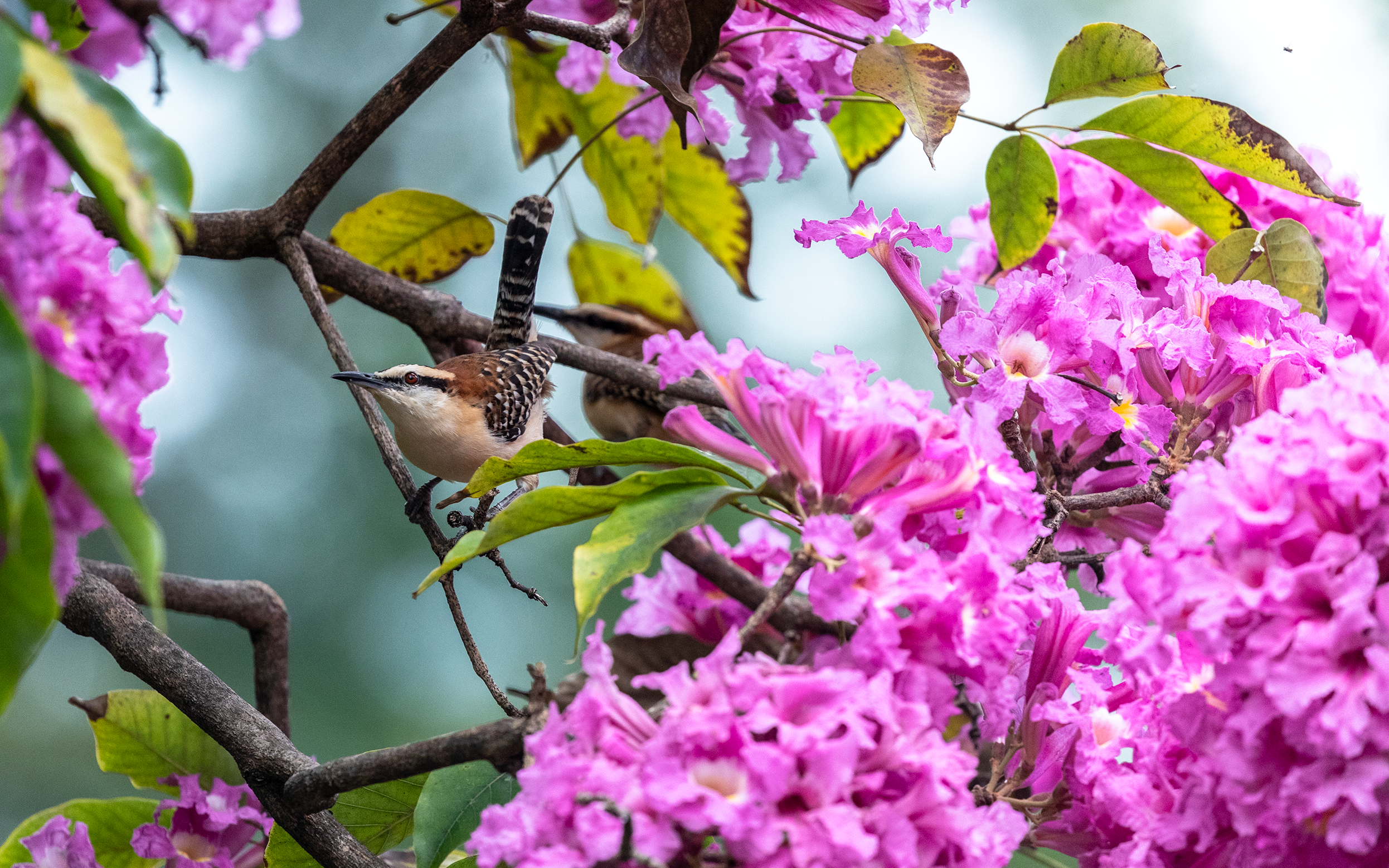
Widespread but often local large wren with pronounced geographic variation in appearance. Usually in small groups, less often in pairs. Mainly found in thorn forest and dry scrubby habitats, but also (rufous-backed form) in more humid scrub and semiopen areas on coastal slope of Chiapas where can be confused with Giant Wren.
COSTA RICA . 2020

Widespread but often local large wren with pronounced geographic variation in appearance. Usually in small groups, less often in pairs. Mainly found in thorn forest and dry scrubby habitats, but also (rufous-backed form) in more humid scrub and semiopen areas on coastal slope of Chiapas where can be confused with Giant Wren.
COSTA RICA . 2020
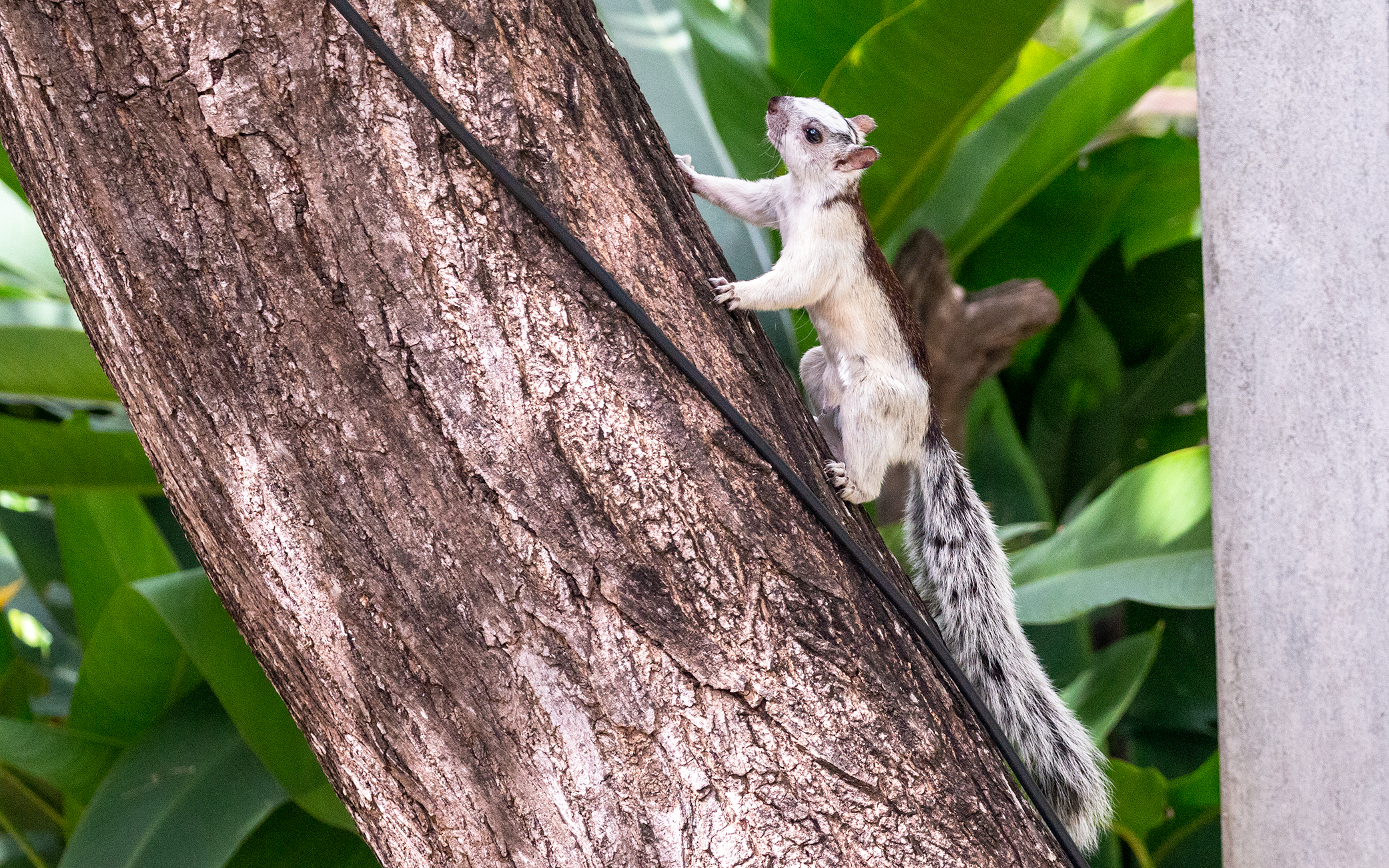
Variegated squirrels are found in North and Central America, from southern Chiapas, Mexico to Central Panama.
COSTA RICA . 2020
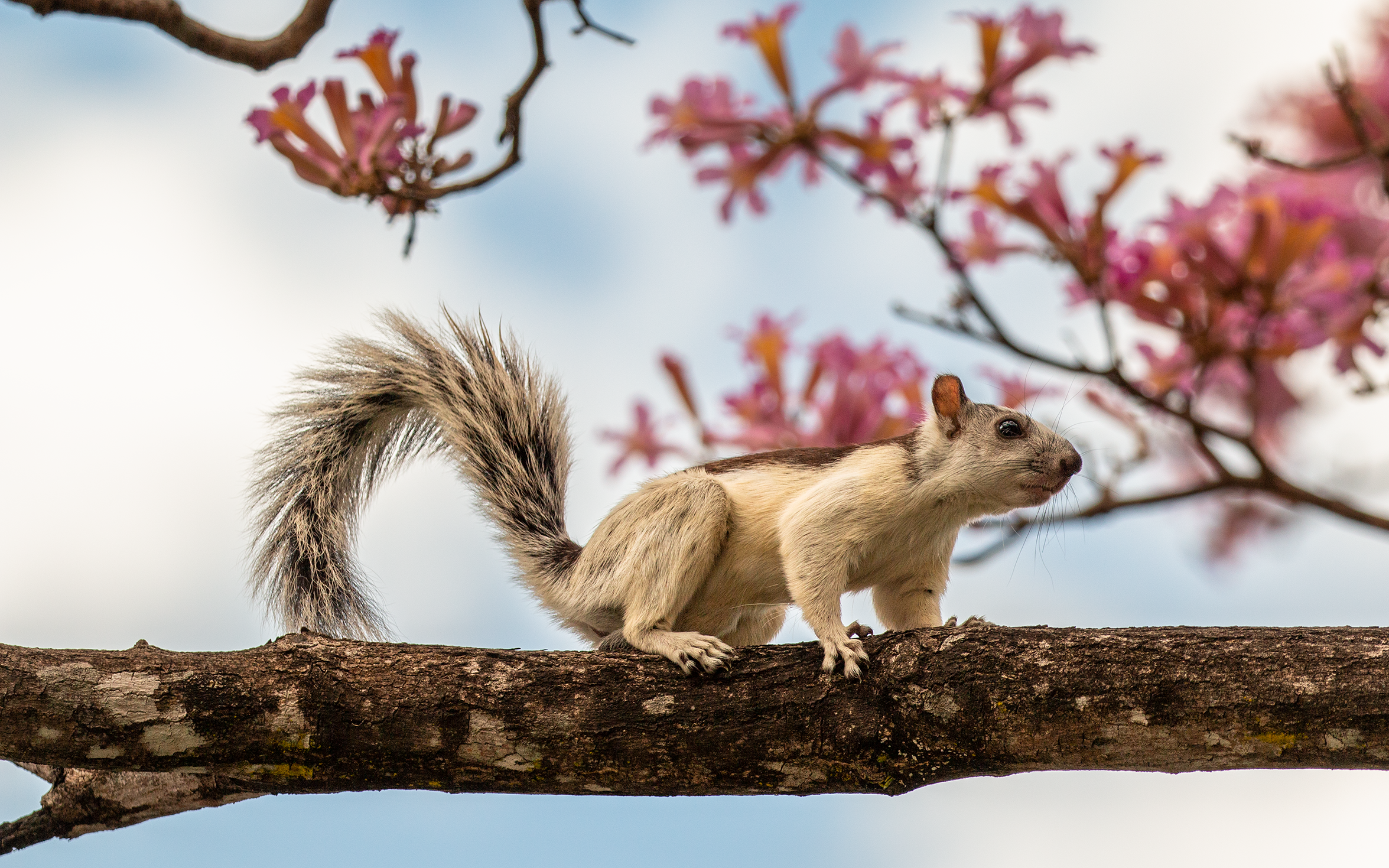
Variegated squirrels are found in North and Central America, from southern Chiapas, Mexico to Central Panama.
COSTA RICA . 2020
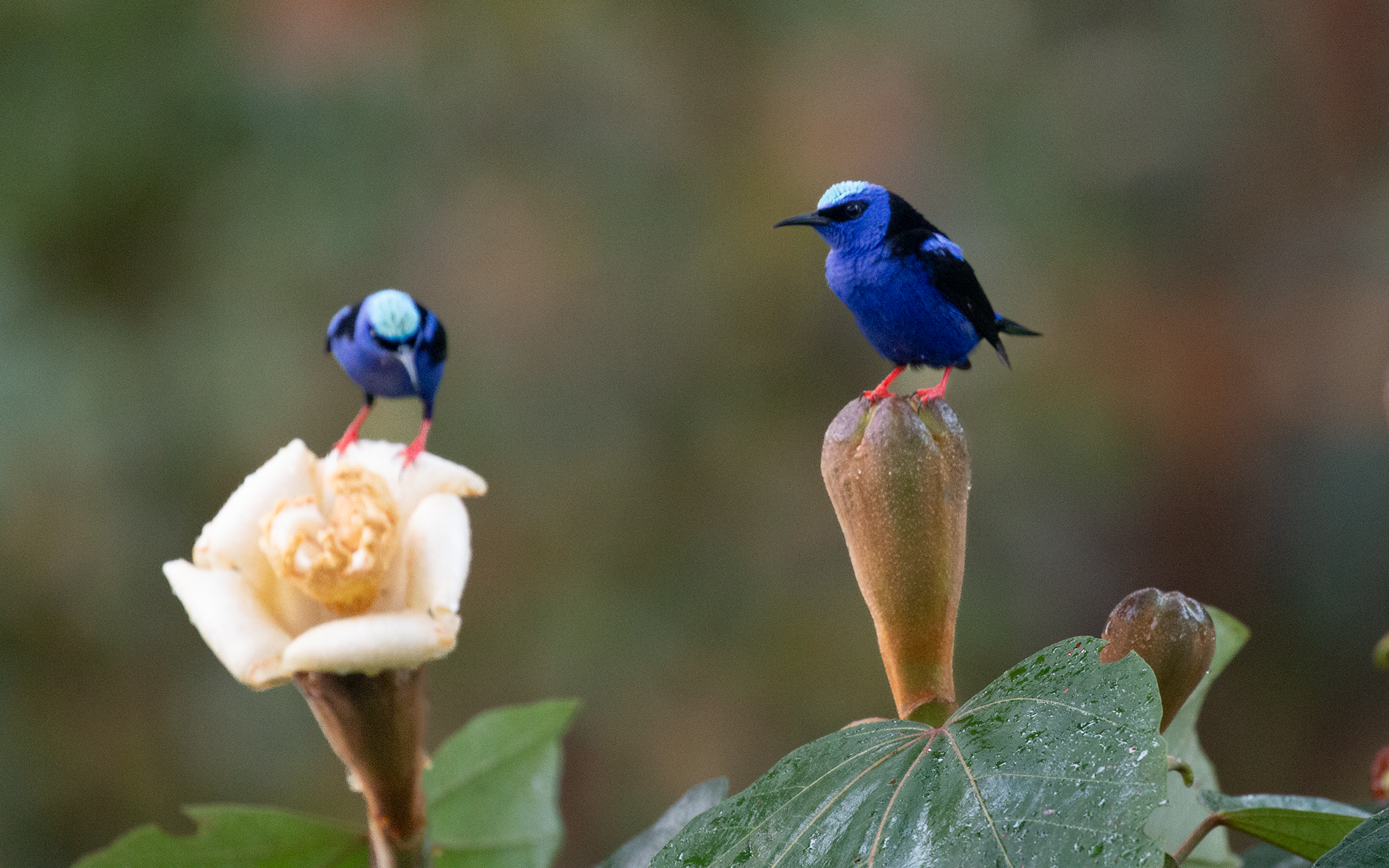
Small, warbler-like tanager of tropical lowlands. Favors forest edge, woodland, and semi-open areas with taller trees. Often occurs in small groups, sometimes larger flocks, usually in the canopy of flowering trees, where it probes for nectar with its long bill. Red legs are bright on male, dullest on young birds.
COSTA RICA . 2020
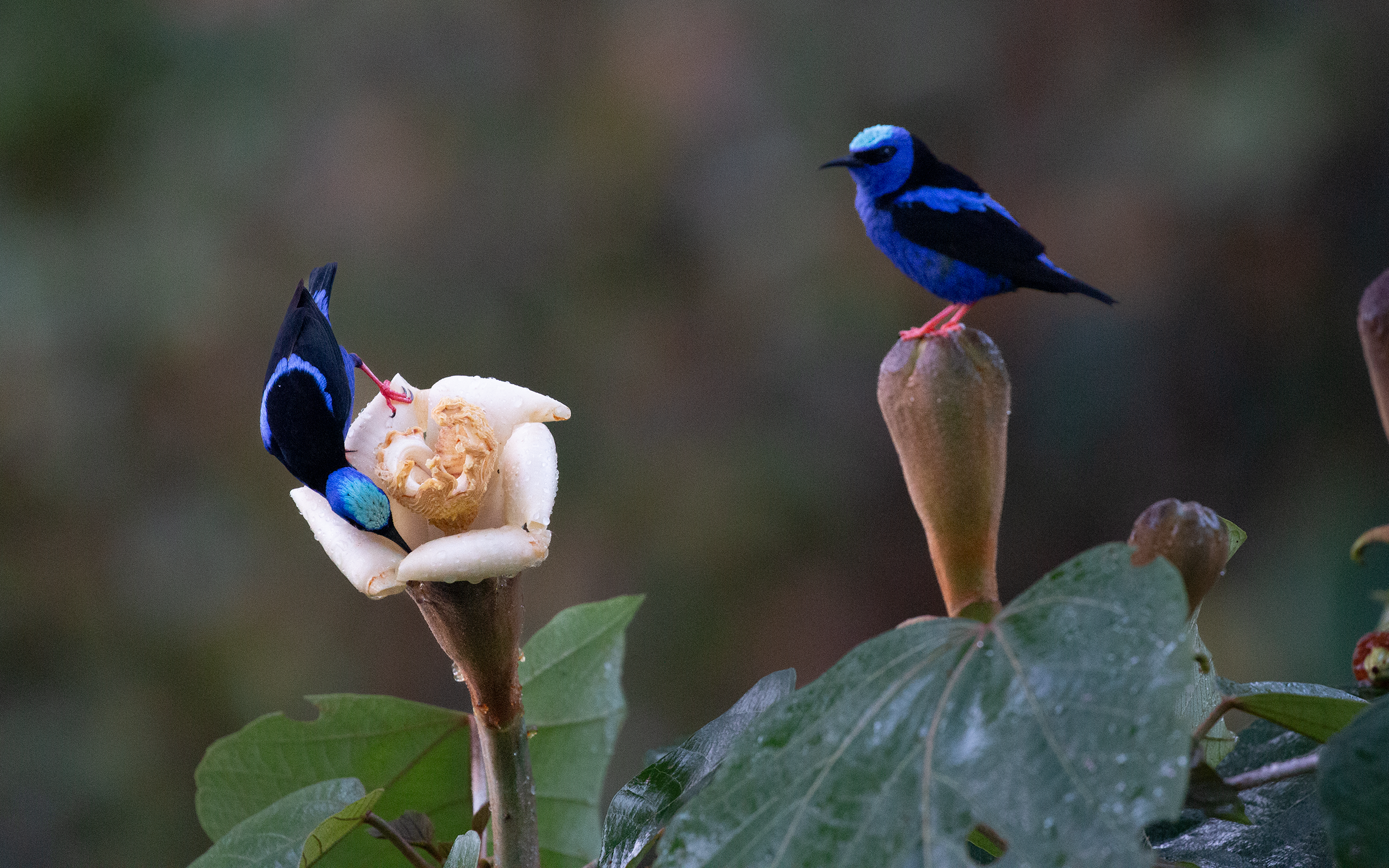
Small, warbler-like tanager of tropical lowlands. Favors forest edge, woodland, and semi-open areas with taller trees. Often occurs in small groups, sometimes larger flocks, usually in the canopy of flowering trees, where it probes for nectar with its long bill. Red legs are bright on male, dullest on young birds.
COSTA RICA . 2020
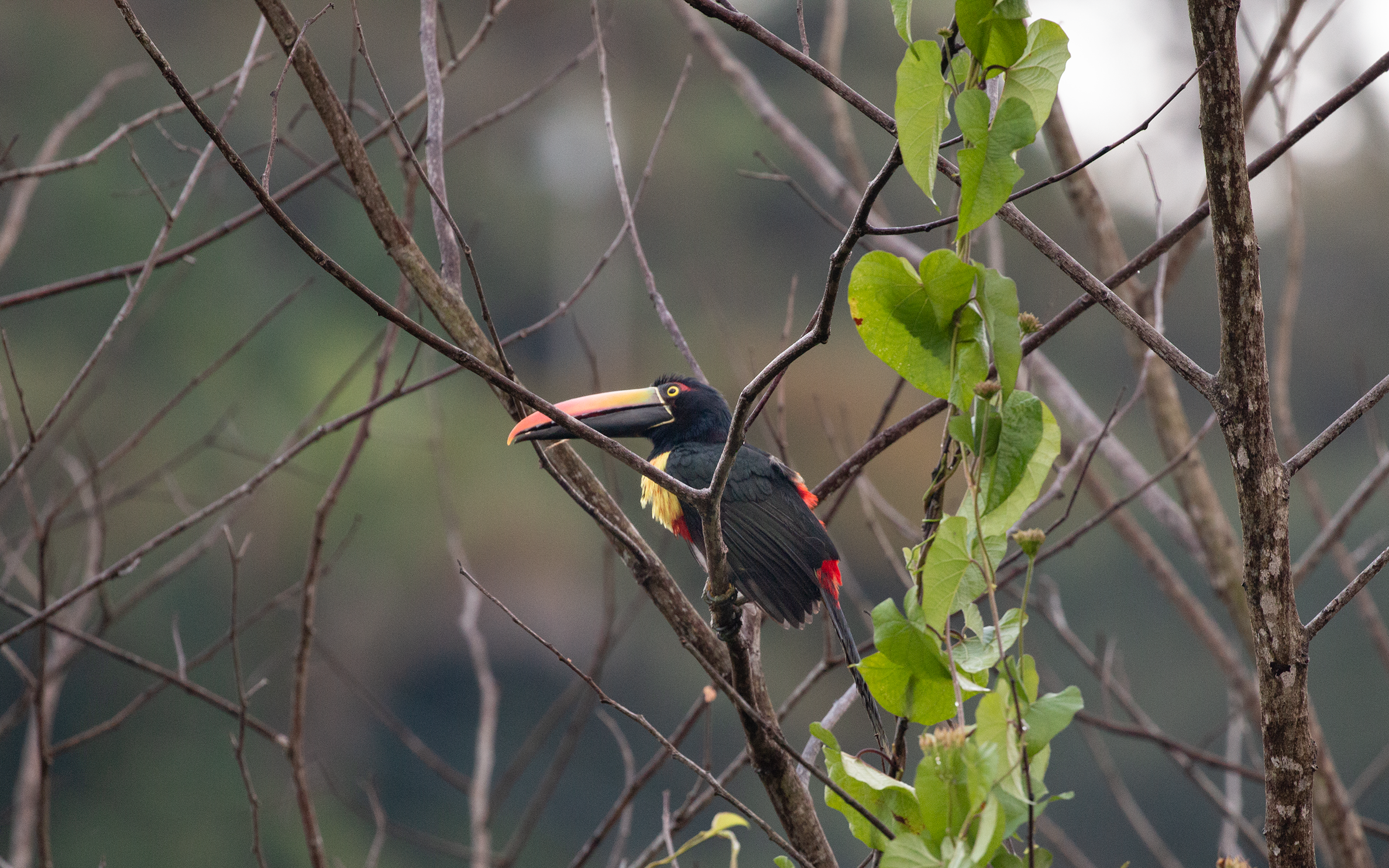
Aracaris are medium-sized toucans, rather slender and long tailed. Fiery-billed is distinctive: the top half of the bill is bright orange. Also note the red belly band. Most often found in small flocks; favors any sort of forested area including edges and gardens.
COSTA RICA . 2020
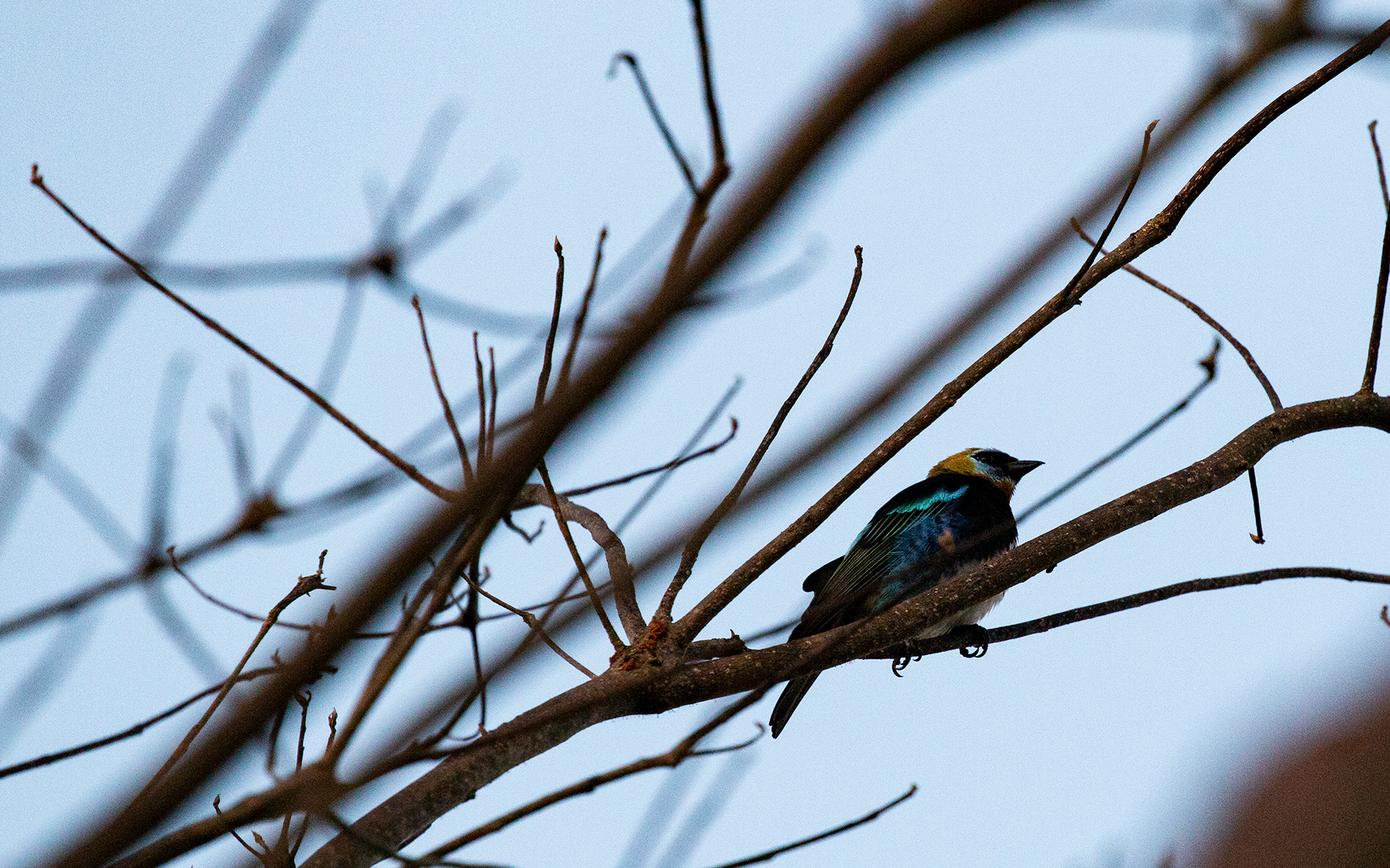
Large motmot of tropical lowland forest and edge, mainly in humid areas. Perches low to high, usually in shady areas. Blue crown with a big black central patch, unlike solid blue of Blue-capped Motmot, which occurs to the north. Plumage overall less contrasting in pattern than Turquoise-browed Motmot, with much smaller tail rackets. The name ‘motmot’ comes from double-hooting call of this species, which can sound like an owl, and is mainly uttered around dawn.
COSTA RICA . 2020
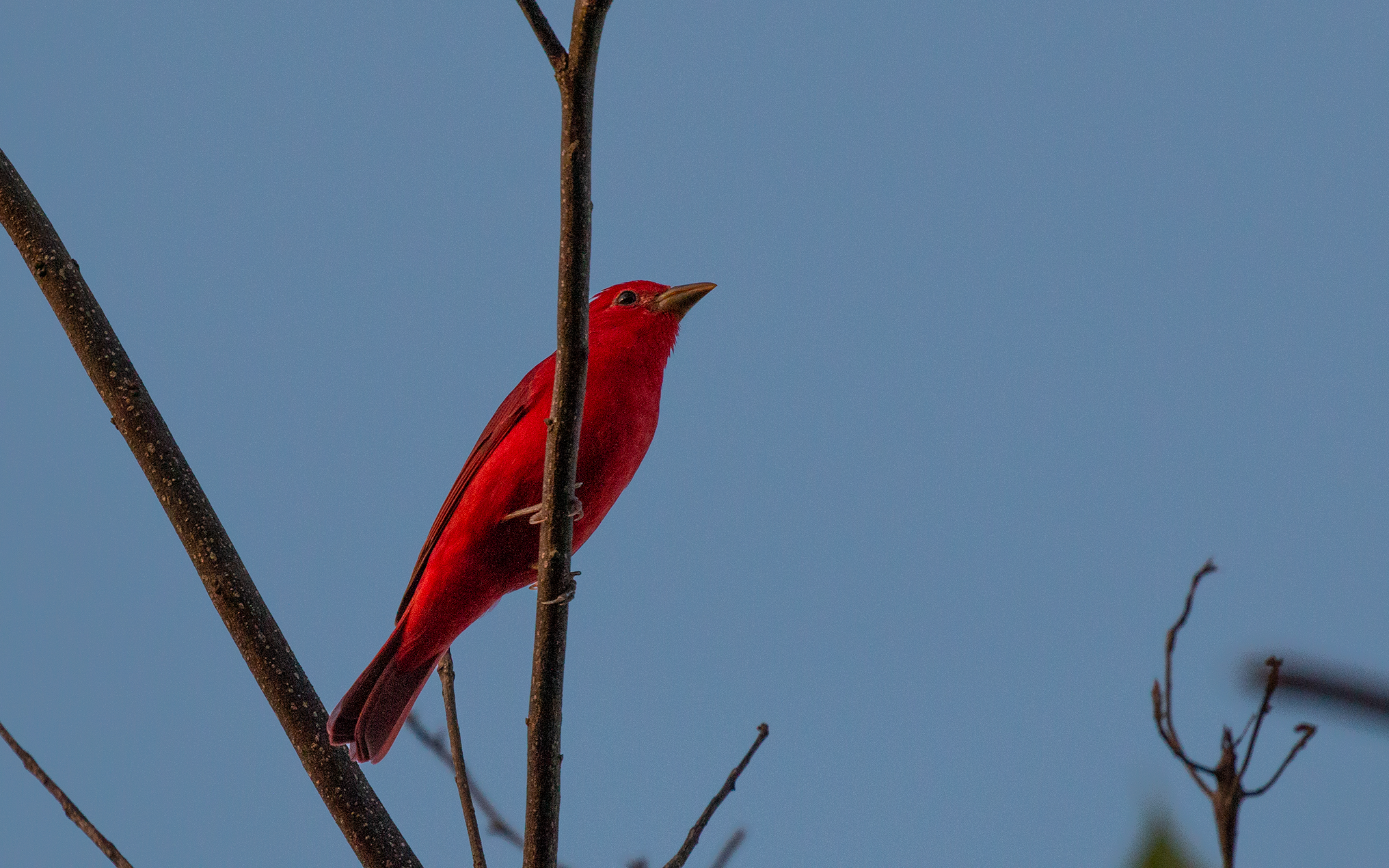
Large tanager with a hefty bill. Adult males are completely red; immature males are dull yellow-olive with blotchy patches of red. Females are variable in color, ranging from pale dull yellow to brighter orange. Can be confused with female Scarlet Tanager; Summer has a longer, paler bill and less contrast between wing and body color.
COSTA RICA . 2020
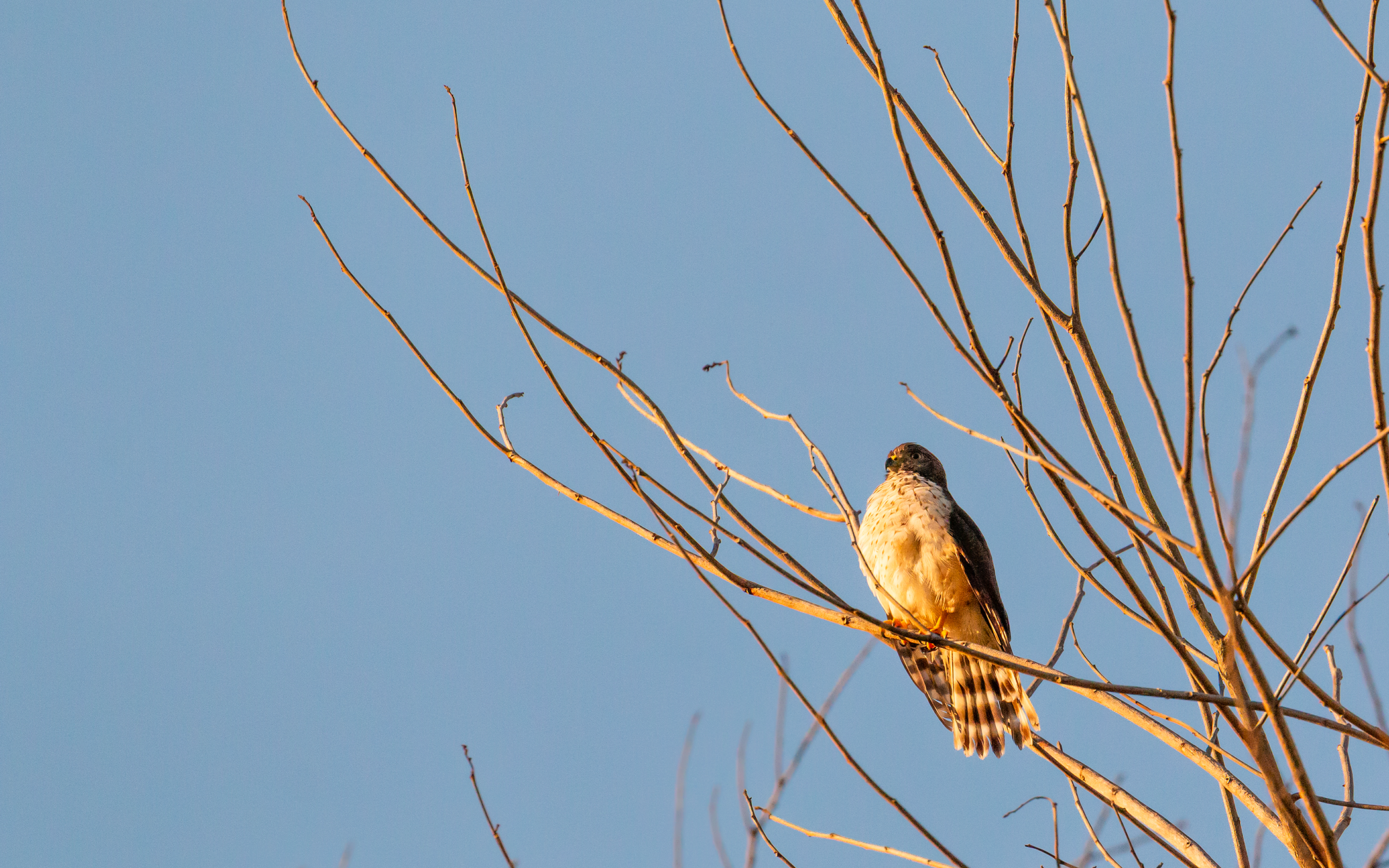
Rather small, compact hawk; about the size of Red-shouldered Hawk, smaller than Red-tailed Hawk. Adults are solid brown above, barred reddish-brown below with bold black-and-white tail bands. Immatures similar, but with blotchier markings below and thin, diffuse tail bands. Distinctive shape in flight: note the short tail, straight leading edge of wing, and bulging secondaries in flight.
COSTA RICA . 2020
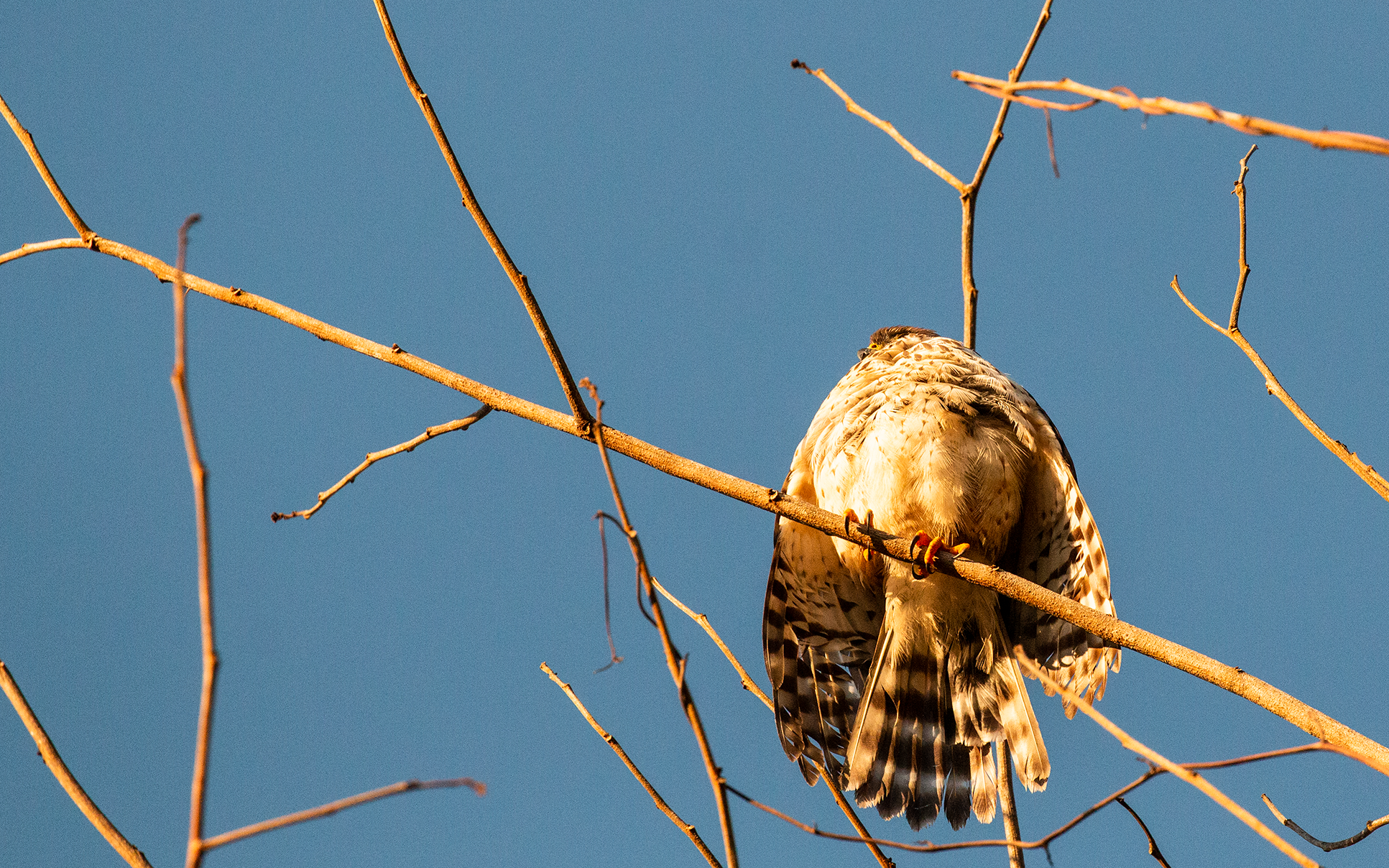
Rather small, compact hawk; about the size of Red-shouldered Hawk, smaller than Red-tailed Hawk. Adults are solid brown above, barred reddish-brown below with bold black-and-white tail bands. Immatures similar, but with blotchier markings below and thin, diffuse tail bands. Distinctive shape in flight: note the short tail, straight leading edge of wing, and bulging secondaries in flight.
COSTA RICA . 2020
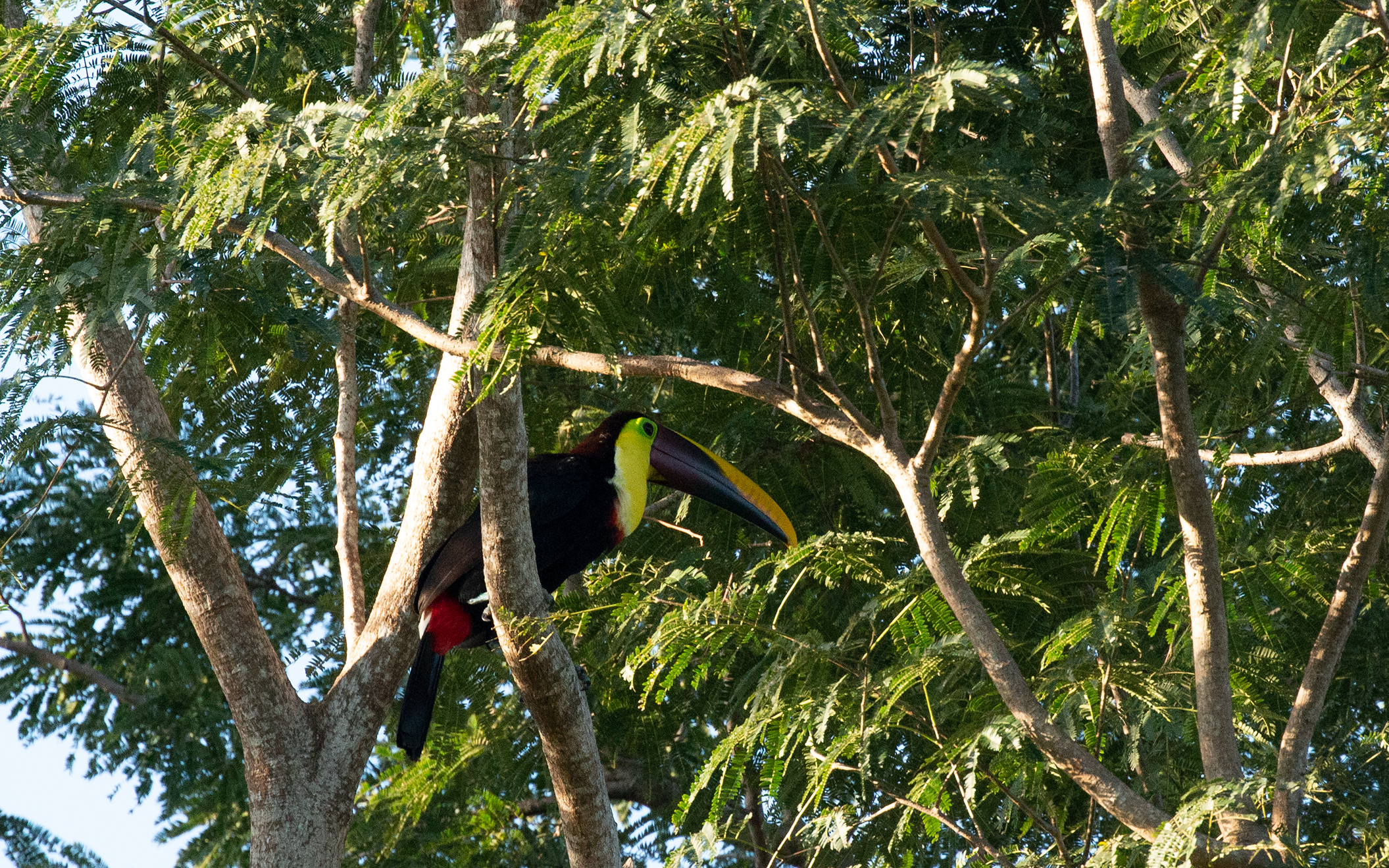
Large conspicuous bird with oversized bill. Mostly black overall with yellow throat and face. Note bicolored bill: dark below and yellow above. Found in pairs or small groups, often parading through the canopy in search of fruit. Sometimes perches very obviously at the top of a tree. Favors forested areas, but can also be found in gardens and edges.
COSTA RICA . 2020

Medium-size, blue-green parrot of tropical lowlands, mainly in humid forest and forest edge. The big white crown patch and white throat on a bluish head are distinctive; also note the pinkish-red patch under the tail.
COSTA RICA . 2020
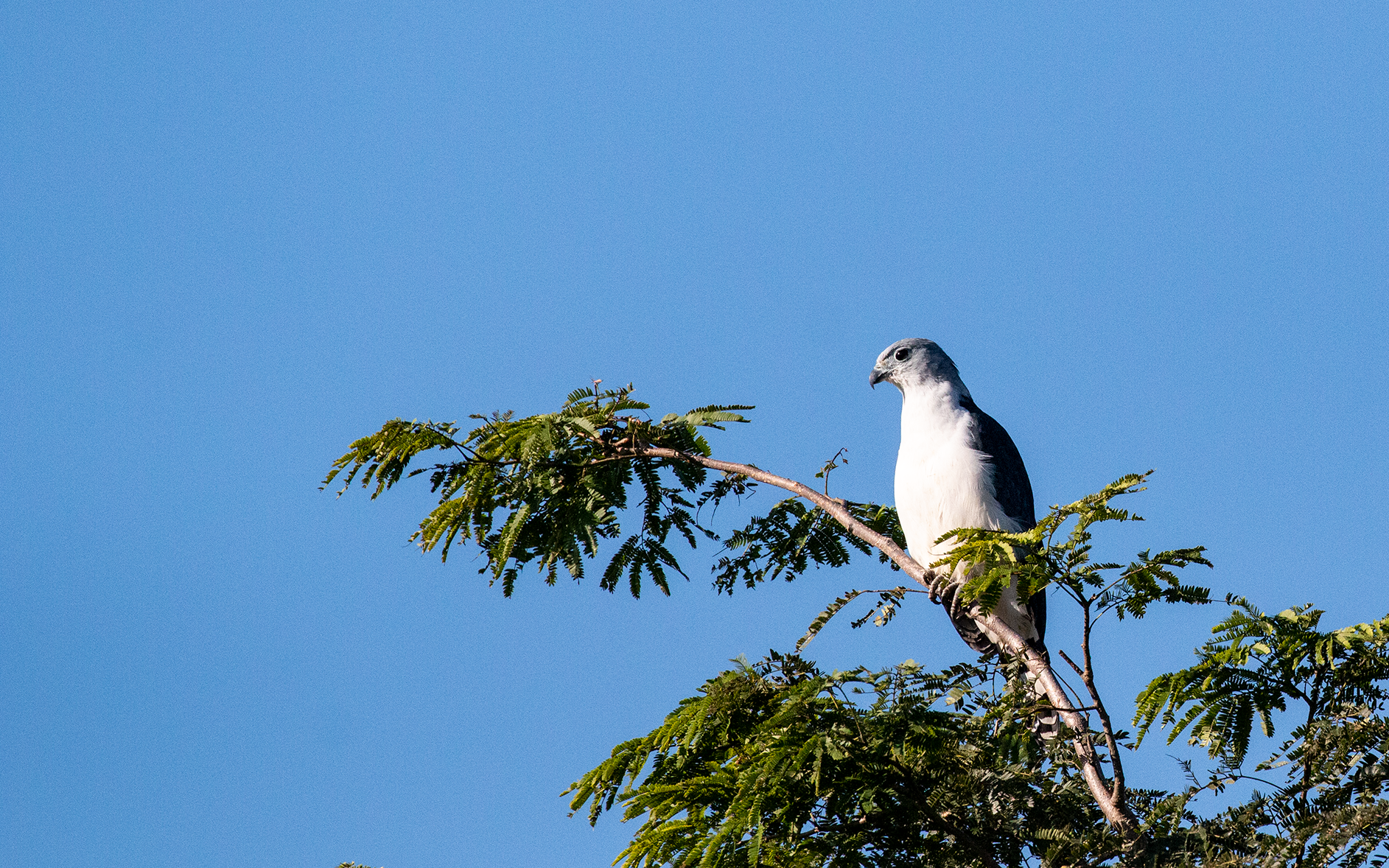
Compact raptor. Adults distinctive, all pale gray with thin white bars on underparts. Tail banded black and white. Juvenile is brown and streaky. Juveniles are similar to juvenile Broad-winged and Red-shouldered Hawks, but have bolder face pattern, paler underwings, and a small white patch at the base of the uppertail.
COSTA RICA . 2020

Large raptor. Appears dark from a distance. Up close, dark brown above with bare red head. In flight, undersides of wings are two-toned; lighter on the entire trailing edge of the wing, opposed to just wingtips on Black Vulture. Wings are held slightly raised when soaring, making a "V" when seen head-on.
COSTA RICA . 2020
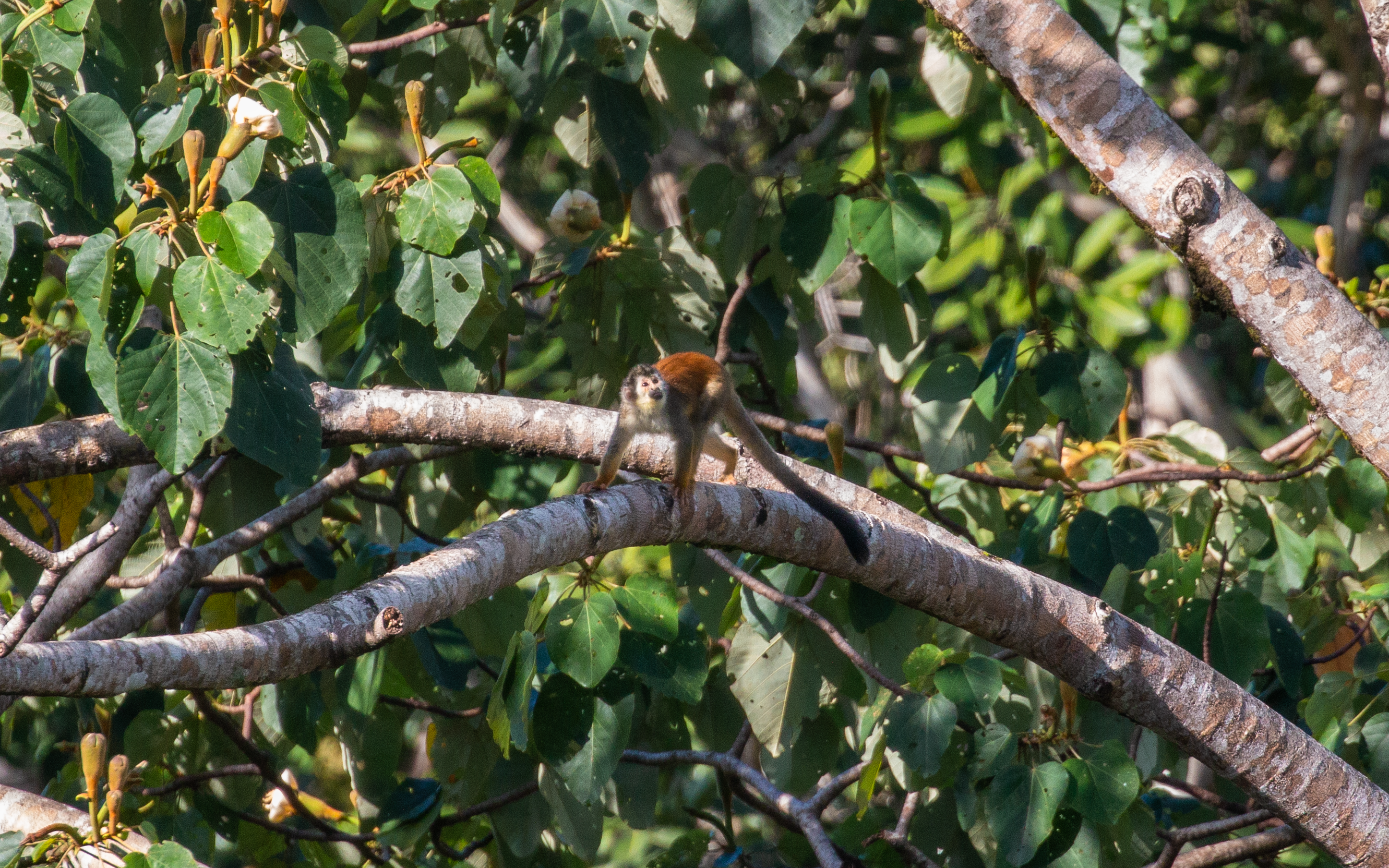
Squirrel monkeys live in the tropical forests of Central and South America in the canopy layer.
COSTA RICA . 2020
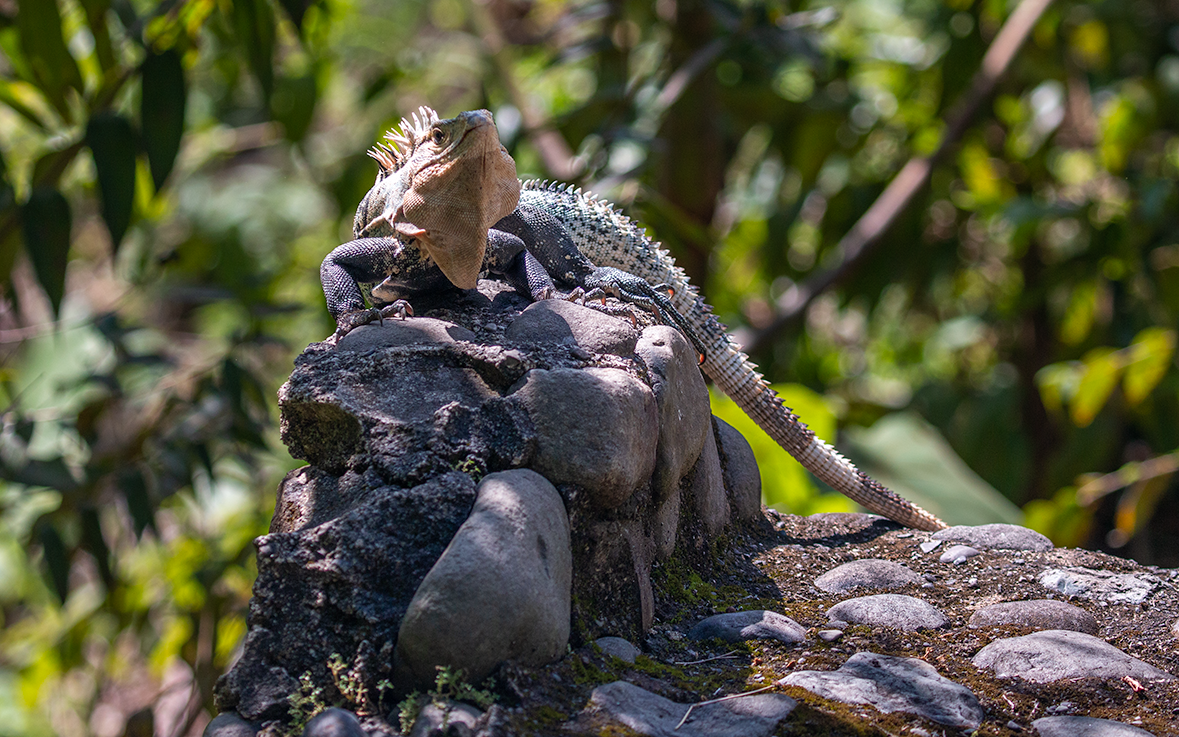
Black spiny-tailed iguanas are excellent climbers, and prefer a rocky habitat with plenty of crevices to hide in, rocks to bask on, and nearby trees to climb.
COSTA RICA . 2020
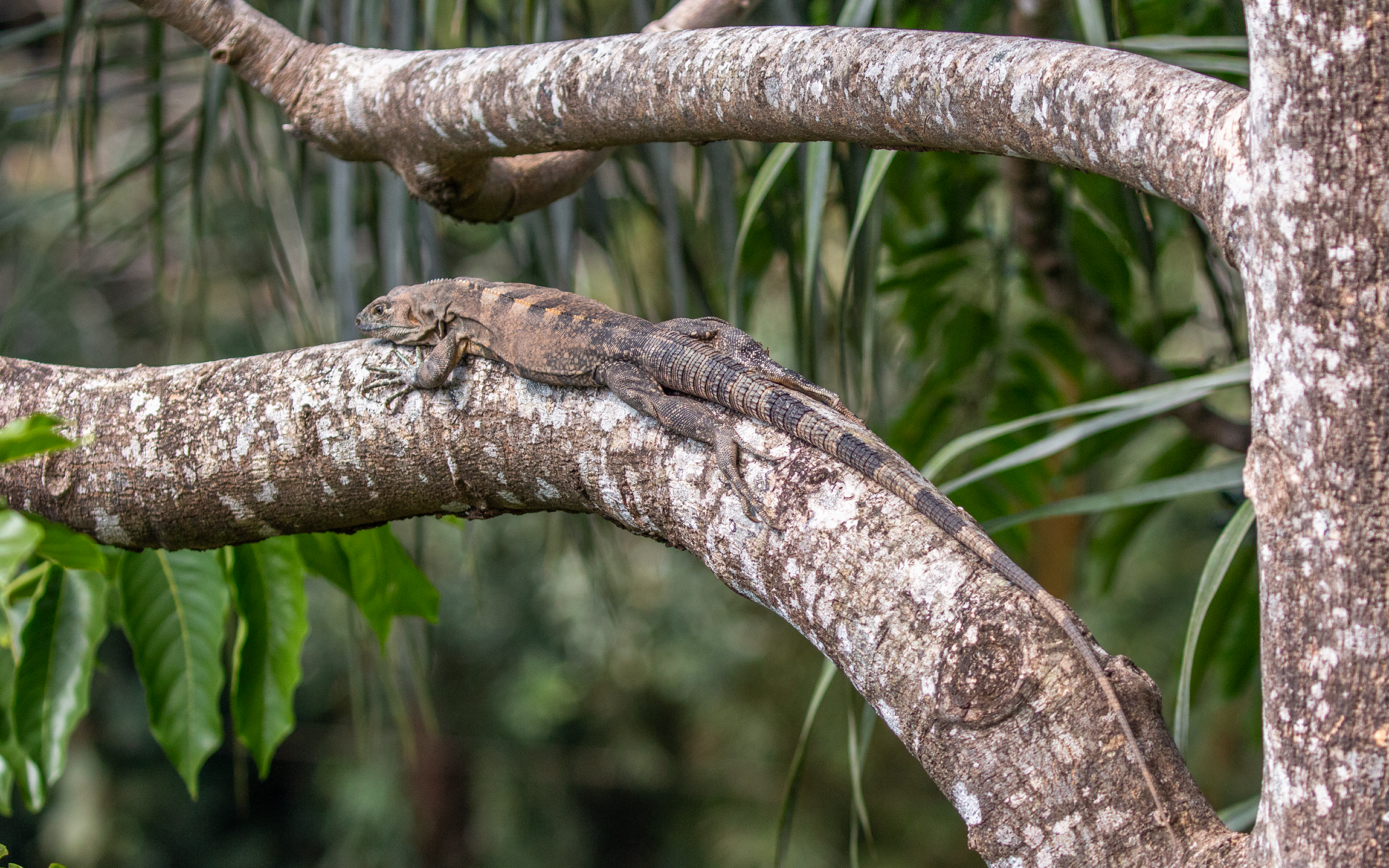
Black spiny-tailed iguanas are excellent climbers, and prefer a rocky habitat with plenty of crevices to hide in, rocks to bask on, and nearby trees to climb.
COSTA RICA . 2020
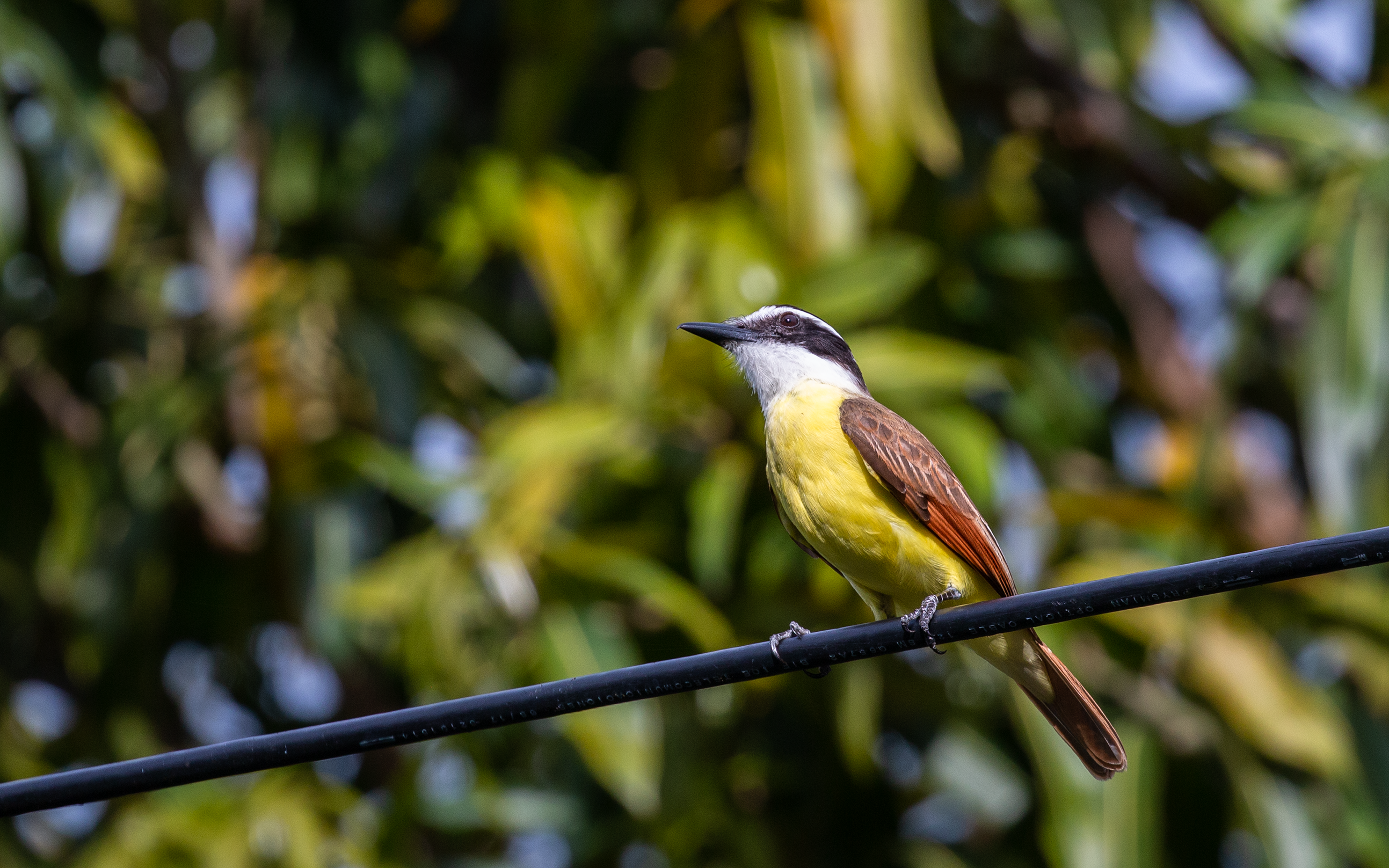
Large, boldly marked, and boisterous flycatcher. Rather stocky with large head and short tail. Looks bright and contrasty with yellow belly, black-and-white head pattern, and rufous wings and tail. Common and widespread throughout Middle and South America, with limited range in the U.S. (Texas). Occurs in shrubby woodlands, often near clearings or bodies of water.
COSTA RICA . 2020
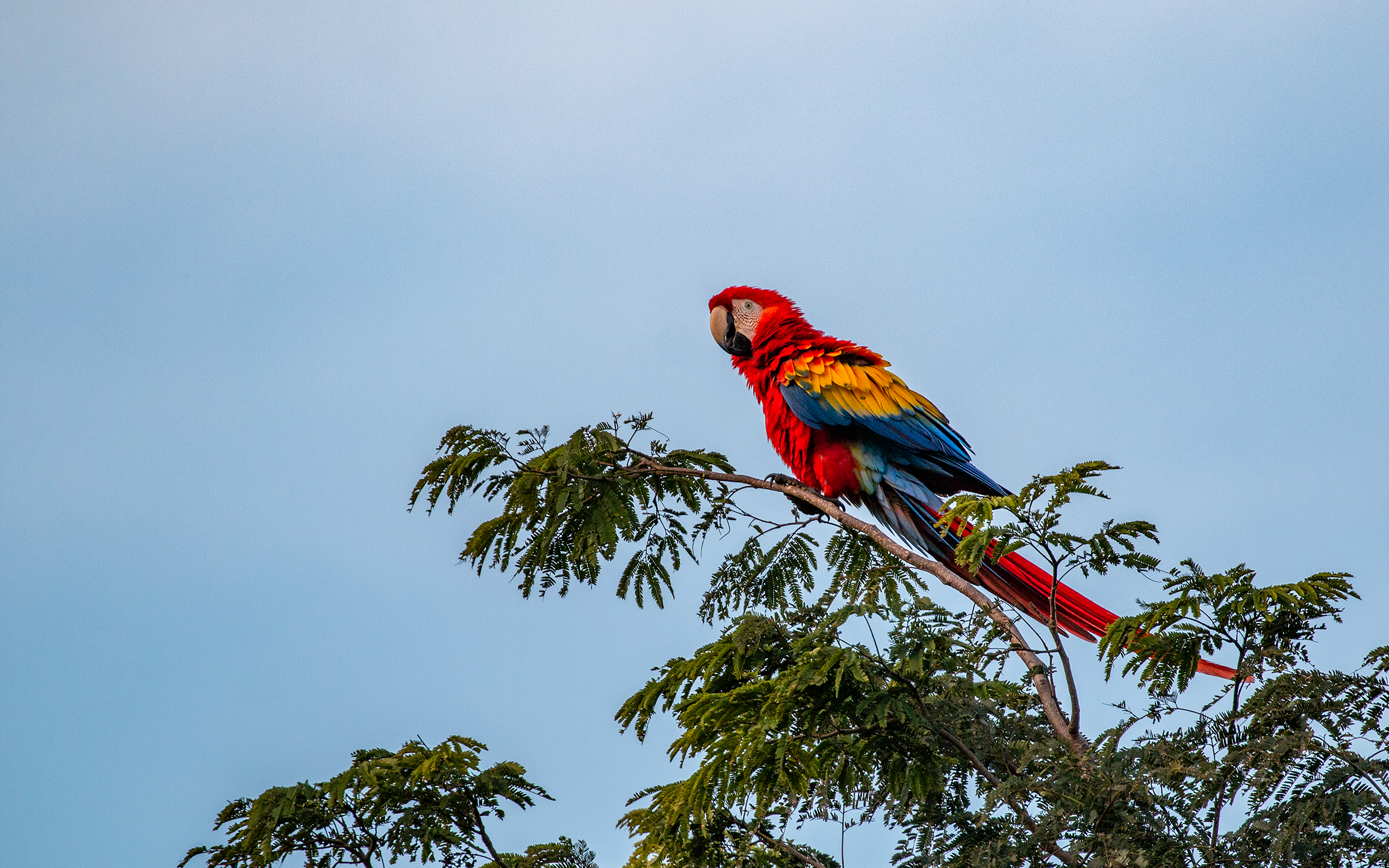
Spectacular, huge, and long-tailed parrot, wiped out from most areas by capture for the pet trade; attempts at reintroduction are taking place in some protected areas. Found very locally in lowland rainforest and adjacent semiopen areas with big trees; usually in pairs. Unmistakable, bright scarlet red overall with big yellow wing patches and mostly blue wings and rump. Calls are deep, throaty roars that carry long distances.
COSTA RICA . 2020
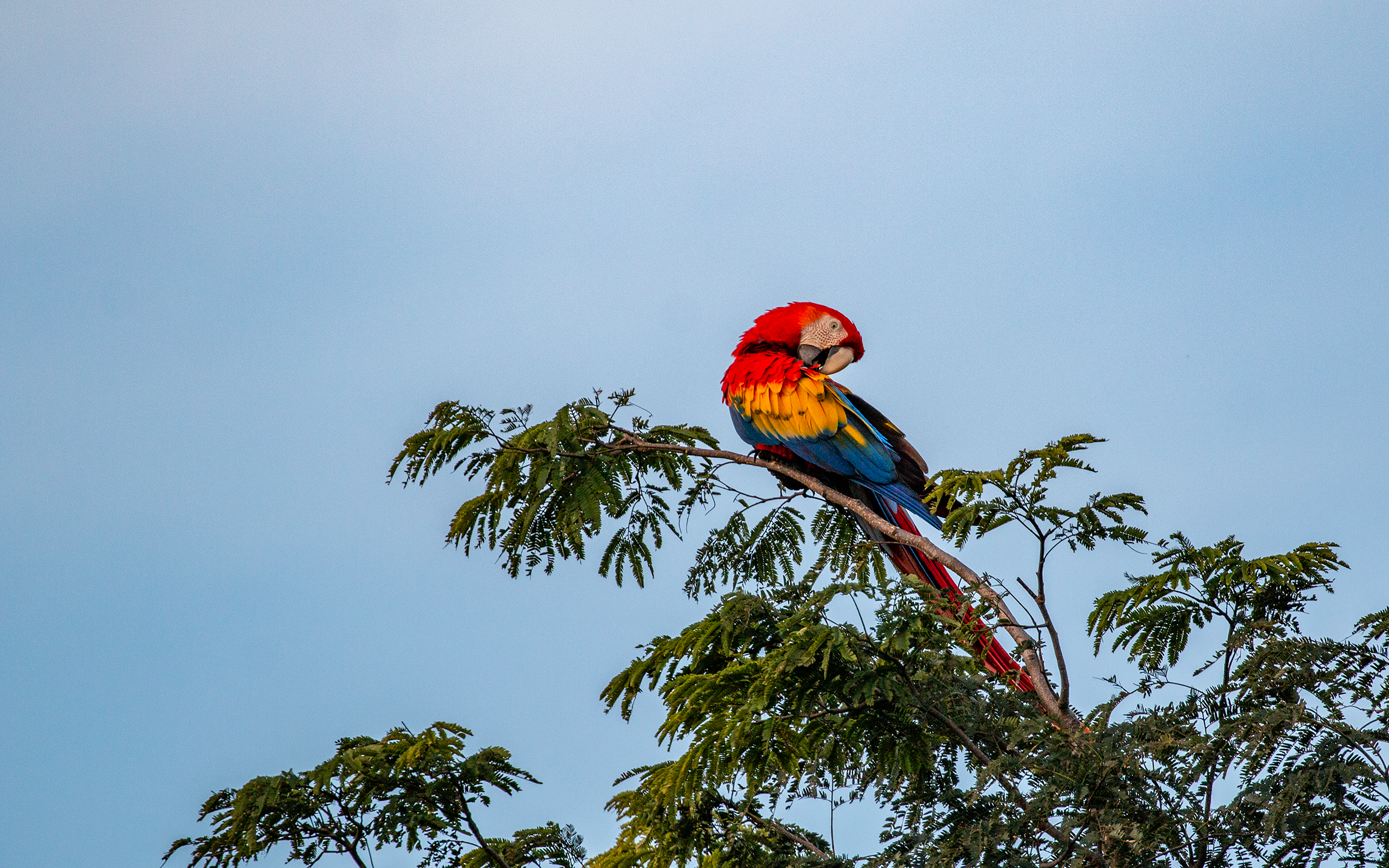
Spectacular, huge, and long-tailed parrot, wiped out from most areas by capture for the pet trade; attempts at reintroduction are taking place in some protected areas. Found very locally in lowland rainforest and adjacent semiopen areas with big trees; usually in pairs. Unmistakable, bright scarlet red overall with big yellow wing patches and mostly blue wings and rump. Calls are deep, throaty roars that carry long distances.
COSTA RICA . 2020
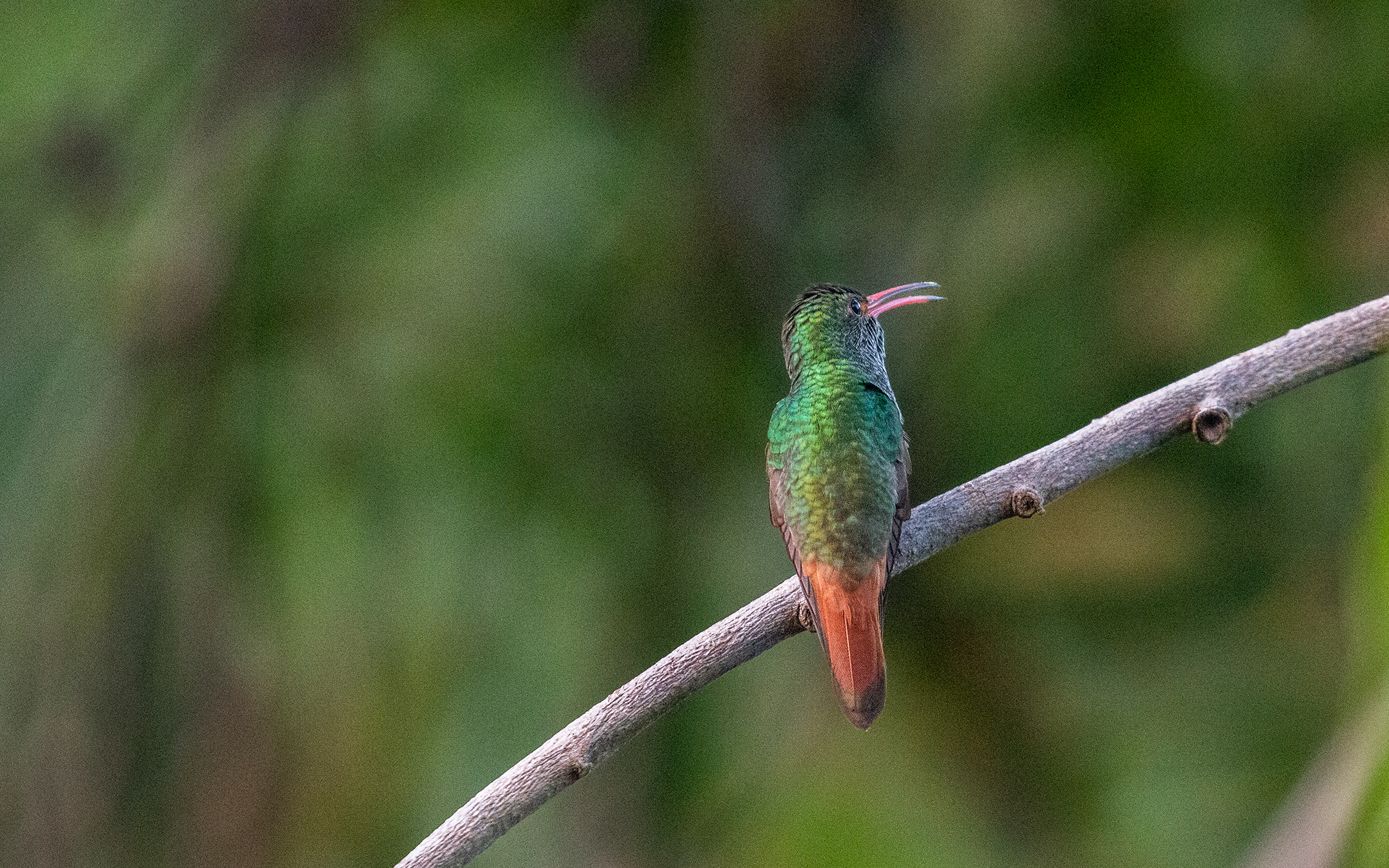
Handsome, medium-size hummingbird of humid tropical lowlands. Favors forest edge, second growth, gardens in some areas. Feeds low to high and often comes to feeders. Can be difficult to distinguish from Buff-bellied Hummingbird, which favors drier habitats. Rufous-tailed has a dingier, grayish belly and more extensive rusty on the tail, which lacks the distinct fork often shown by Buff-bellied’s tail.
COSTA RICA . 2020
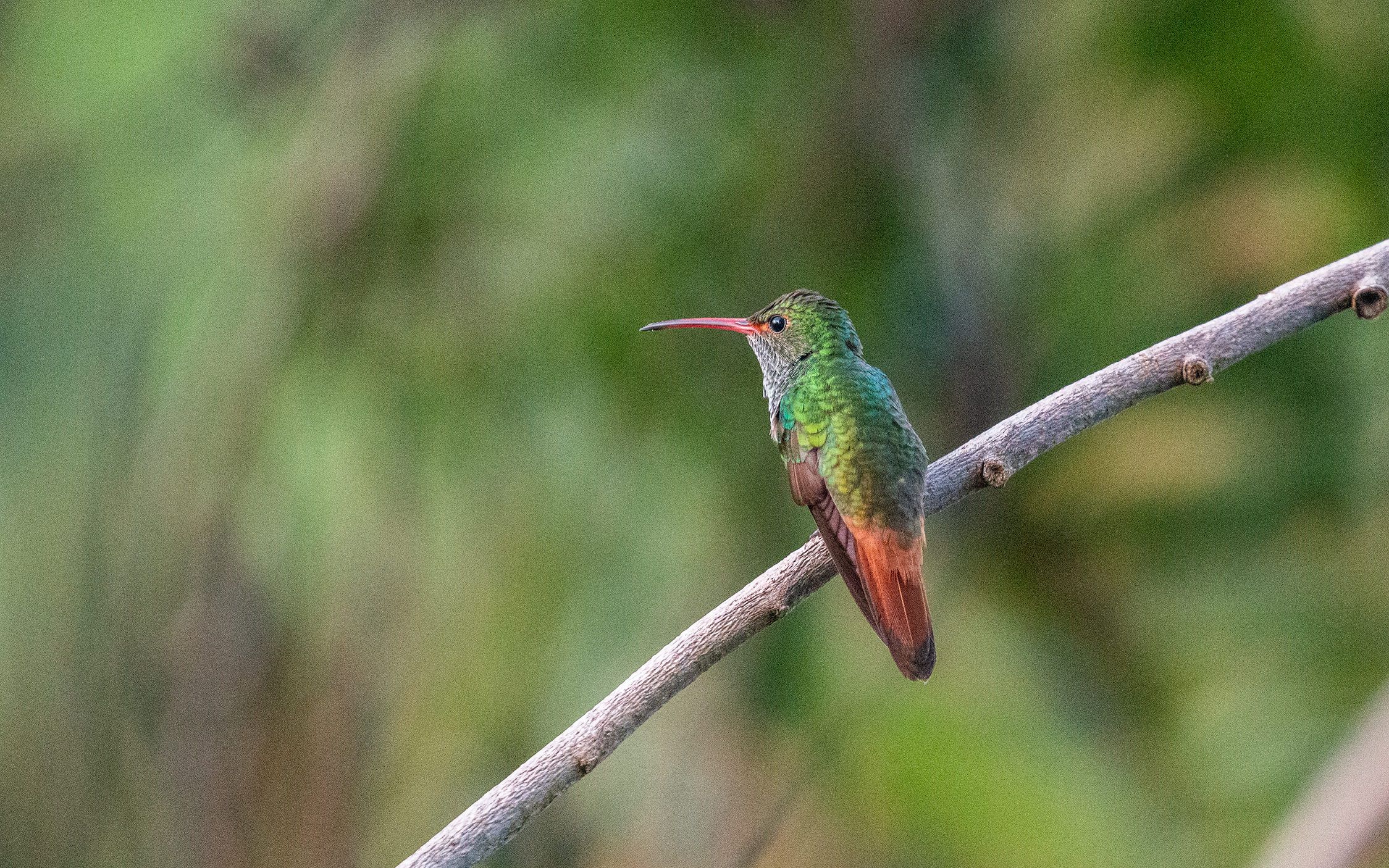
Handsome, medium-size hummingbird of humid tropical lowlands. Favors forest edge, second growth, gardens in some areas. Feeds low to high and often comes to feeders. Can be difficult to distinguish from Buff-bellied Hummingbird, which favors drier habitats. Rufous-tailed has a dingier, grayish belly and more extensive rusty on the tail, which lacks the distinct fork often shown by Buff-bellied’s tail.
COSTA RICA . 2020
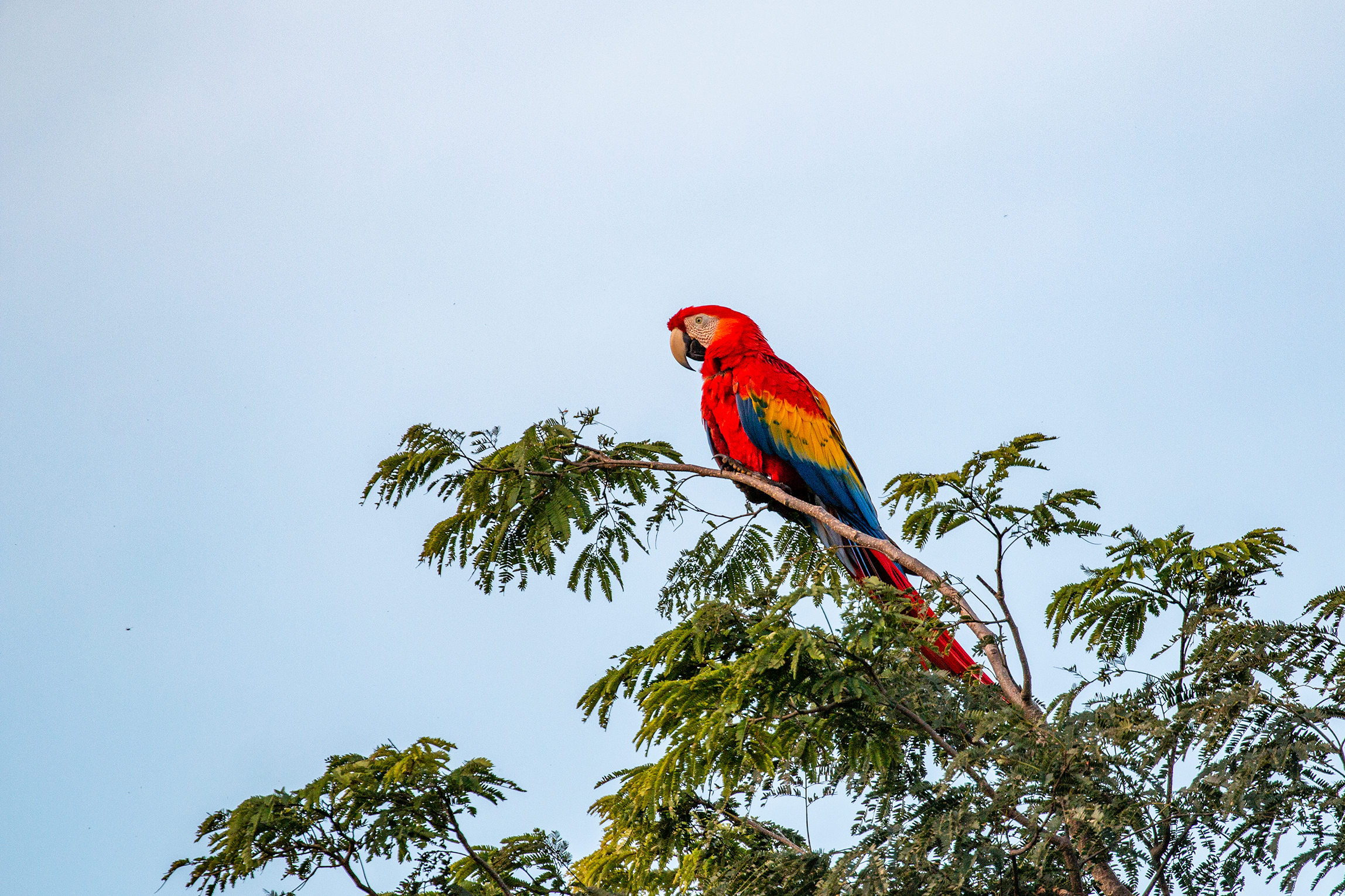
Spectacular, huge, and long-tailed parrot, wiped out from most areas by capture for the pet trade; attempts at reintroduction are taking place in some protected areas. Found very locally in lowland rainforest and adjacent semiopen areas with big trees; usually in pairs. Unmistakable, bright scarlet red overall with big yellow wing patches and mostly blue wings and rump. Calls are deep, throaty roars that carry long distances.
COSTA RICA . 2020
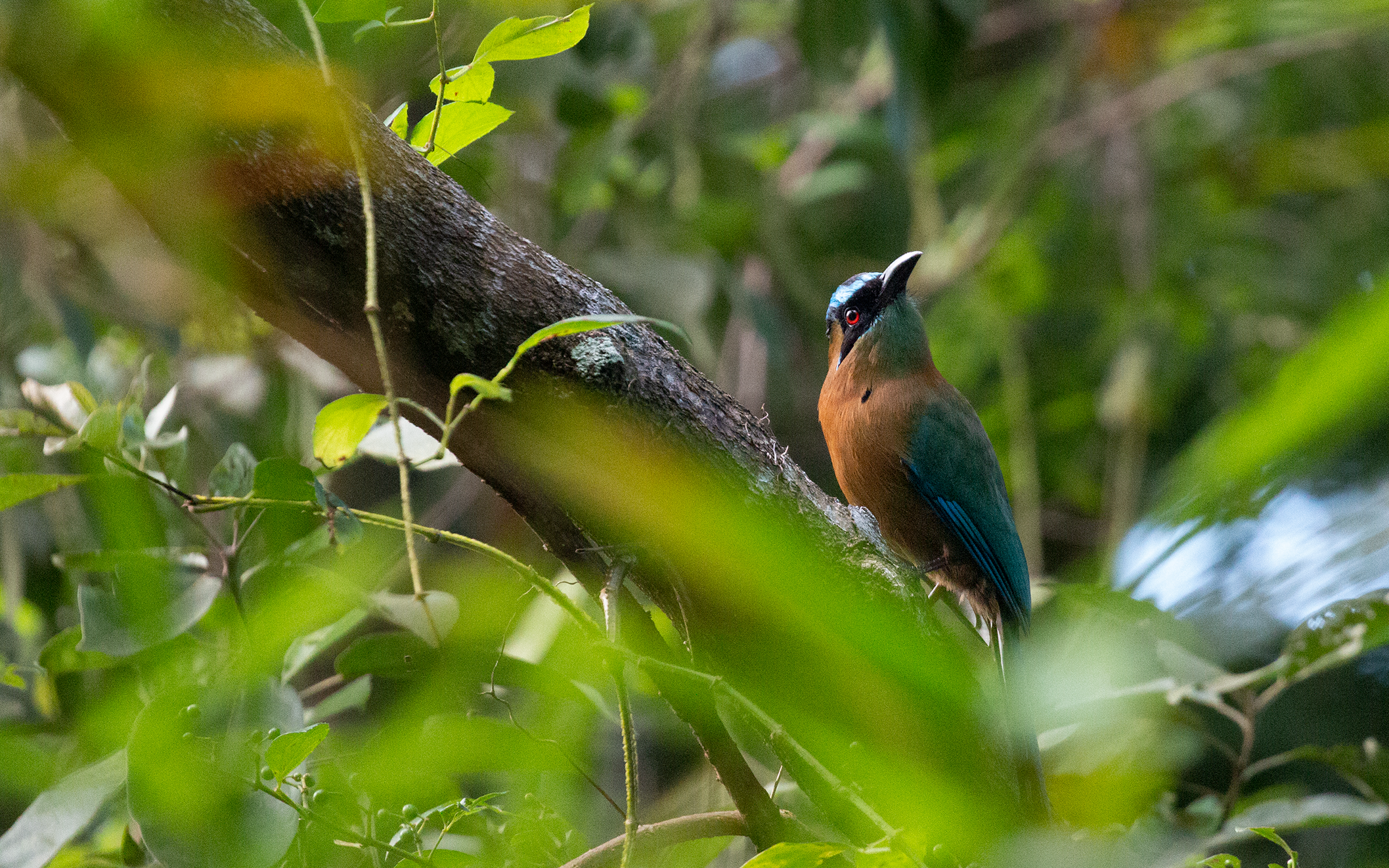
Large motmot of tropical lowland forest and edge, mainly in humid areas. Perches low to high, usually in shady areas. Blue crown with a big black central patch, unlike solid blue of Blue-capped Motmot, which occurs to the north. Plumage overall less contrasting in pattern than Turquoise-browed Motmot, with much smaller tail rackets. The name ‘motmot’ comes from double-hooting call of this species, which can sound like an owl, and is mainly uttered around dawn.
COSTA RICA . 2020
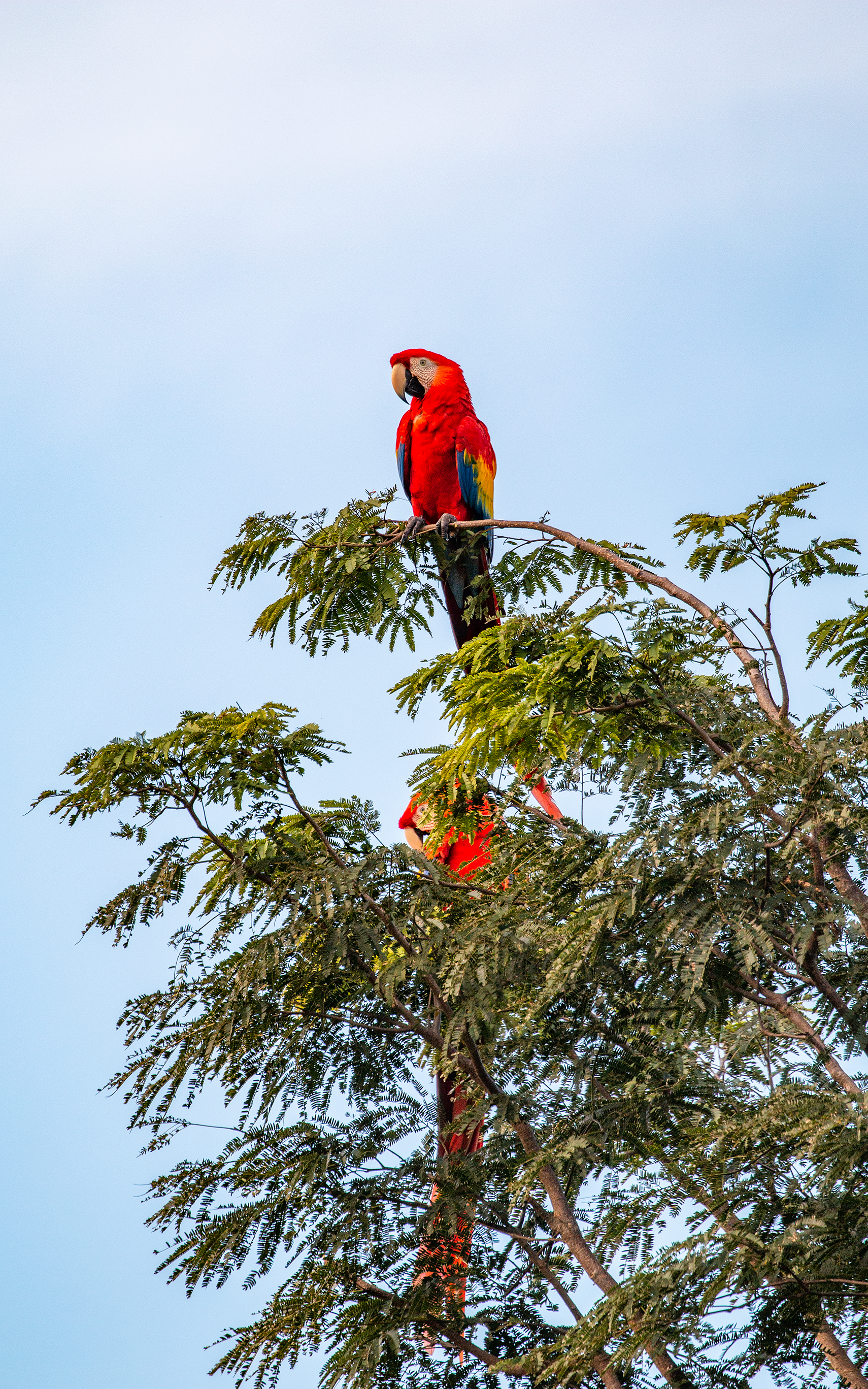
Spectacular, huge, and long-tailed parrot, wiped out from most areas by capture for the pet trade; attempts at reintroduction are taking place in some protected areas. Found very locally in lowland rainforest and adjacent semiopen areas with big trees; usually in pairs. Unmistakable, bright scarlet red overall with big yellow wing patches and mostly blue wings and rump. Calls are deep, throaty roars that carry long distances.
COSTA RICA . 2020
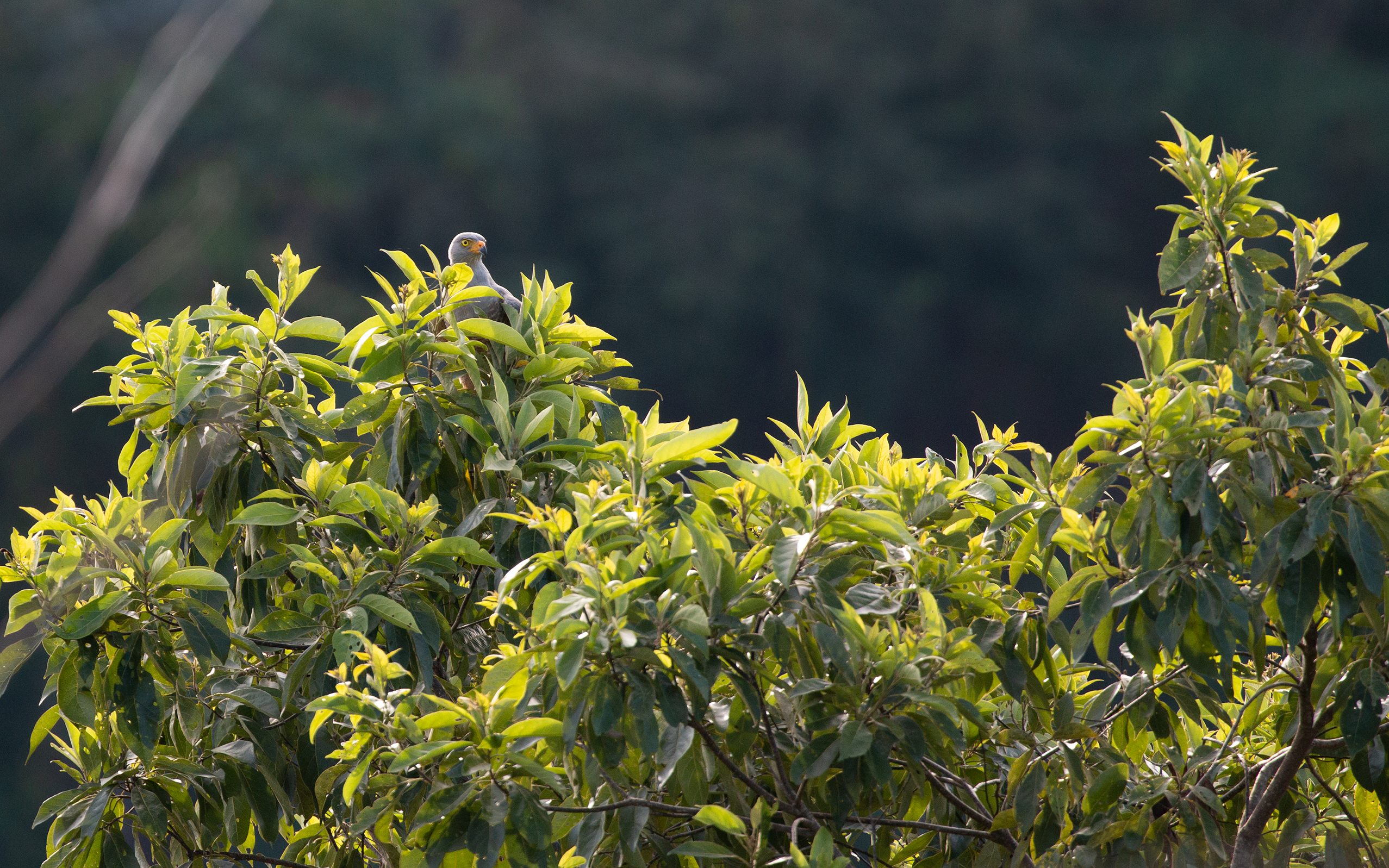
An aptly-named entirely black hawk with broad wings and short tail with a distinct white band. Flight feathers are slightly paler and it has long yellow legs and yellow on the base of the bill. Immature birds are streaky brown with dark moustache and pale eyebrow.
COSTA RICA . 2020
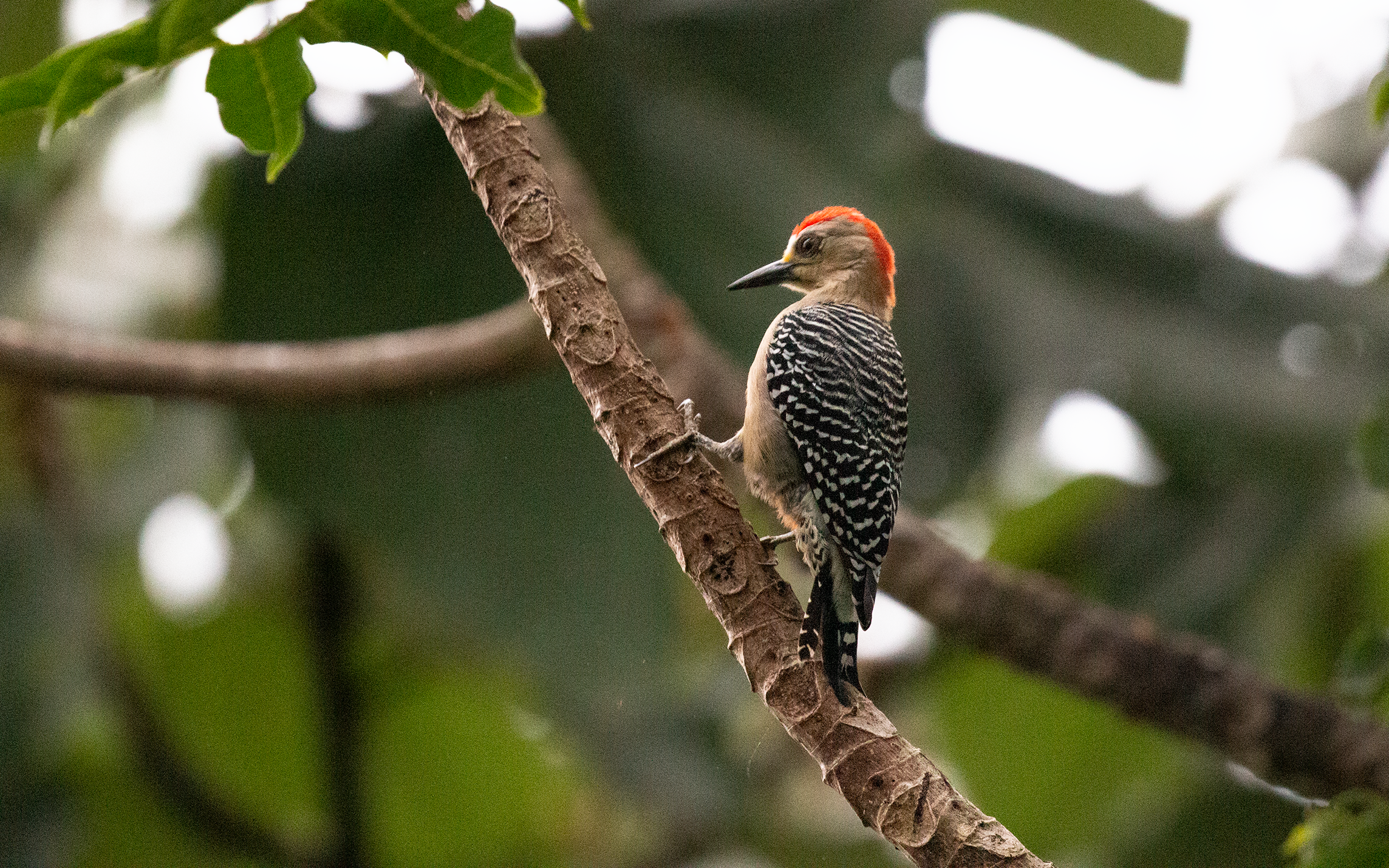
Medium-sized woodpecker found from Costa Rica to northern South America. Pale buffy overall with a red nape and belly and black-and-white barring on the back. Female has a pale crown with restricted red on the back of the nape; male has red extending to top of crown. Common in open woodlands, second growth, and gardens.
COSTA RICA . 2020
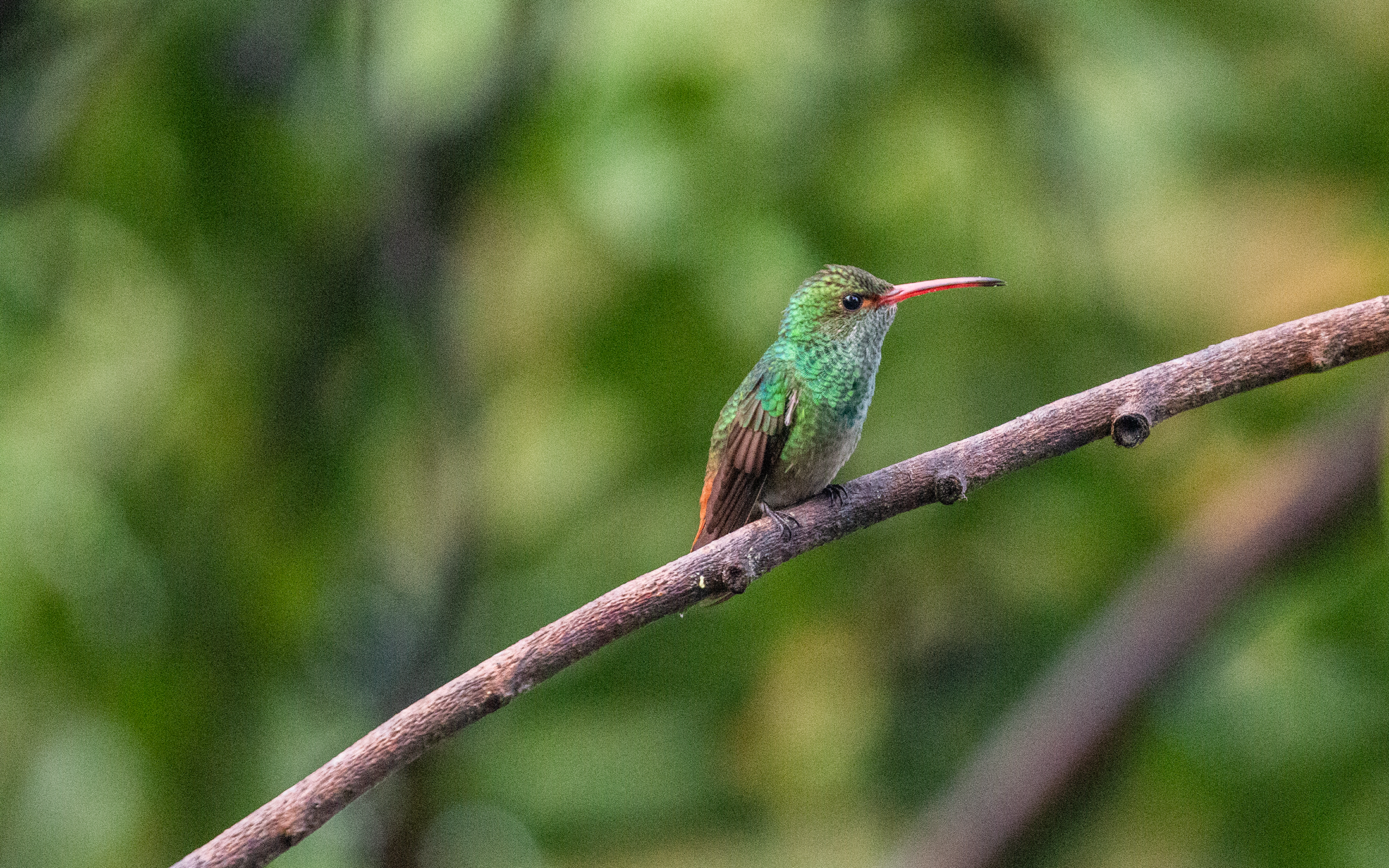
Handsome, medium-size hummingbird of humid tropical lowlands. Favors forest edge, second growth, gardens in some areas. Feeds low to high and often comes to feeders. Can be difficult to distinguish from Buff-bellied Hummingbird, which favors drier habitats. Rufous-tailed has a dingier, grayish belly and more extensive rusty on the tail, which lacks the distinct fork often shown by Buff-bellied’s tail.
COSTA RICA . 2020

Striking and familiar backyard bird throughout most of eastern North America; also occurs in the southwestern U.S. and fairly extensively in Mexico. Crest, large red bill, and long tail render this species distinctive even with a poor view. Male is entirely red with a black face. Female is brownish overall with redder wings and tail. Usually seen in pairs or small groups near dense cover, especially thickets near forest edges.
CULLINAN PARK . SUAGR LAND . TX . 2022

Striking and familiar backyard bird throughout most of eastern North America; also occurs in the southwestern U.S. and fairly extensively in Mexico. Crest, large red bill, and long tail render this species distinctive even with a poor view. Male is entirely red with a black face. Female is brownish overall with redder wings and tail. Usually seen in pairs or small groups near dense cover, especially thickets near forest edges.
CULLINAN PARK . SUAGR LAND . TX . 2022
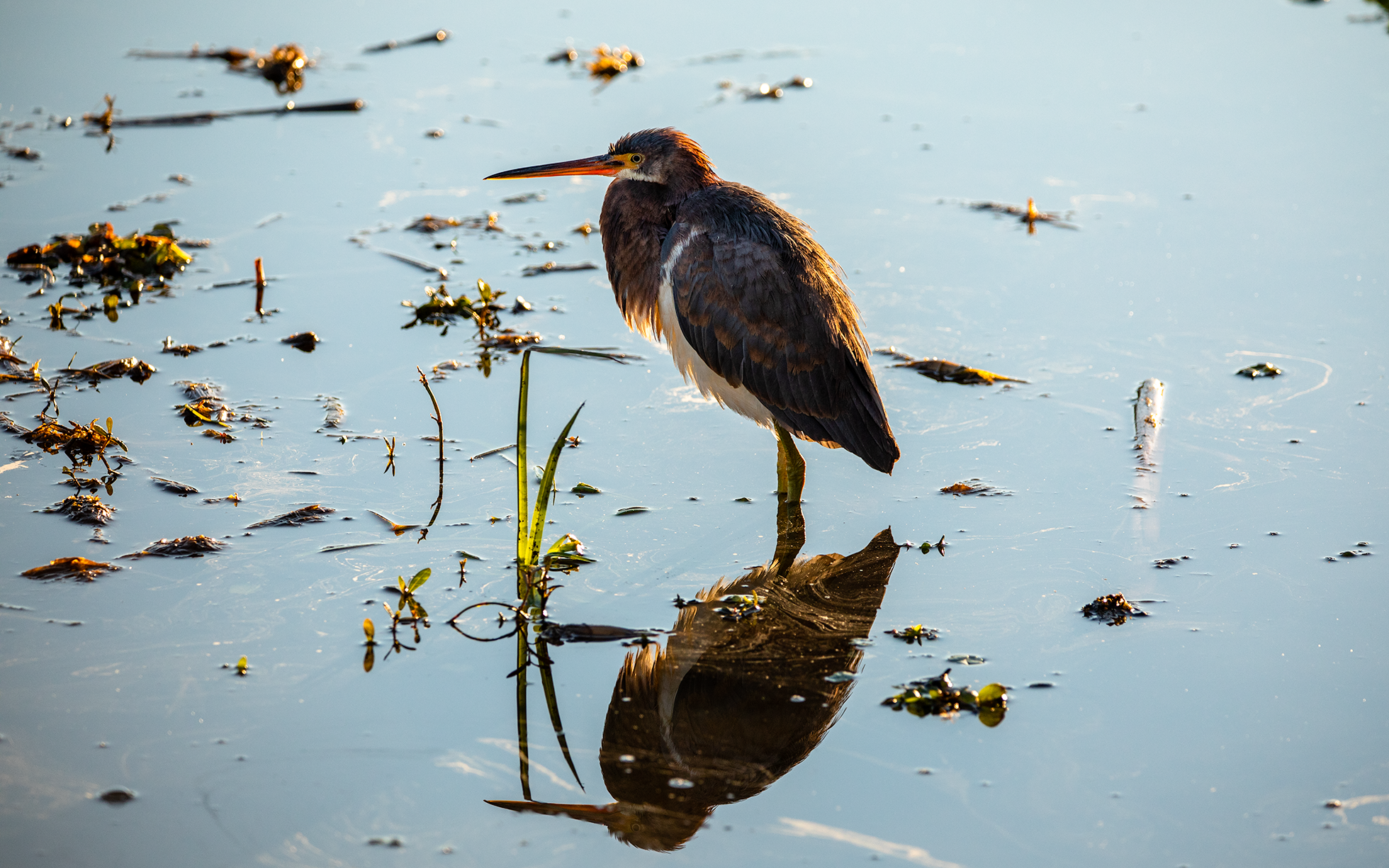
Small, dark heron with a blue-green back, rusty-colored neck and dark cap. Usually in a crouched position, partly concealed in vegetation, waiting patiently for prey. In flight, looks like an awkward crow with broad wings, neck tucked in, and legs extending just beyond the tail. Often vocal when flushed; gives a sharp "skeiw!"
CULLINAN PARK . SUAGR LAND . TX . 2022
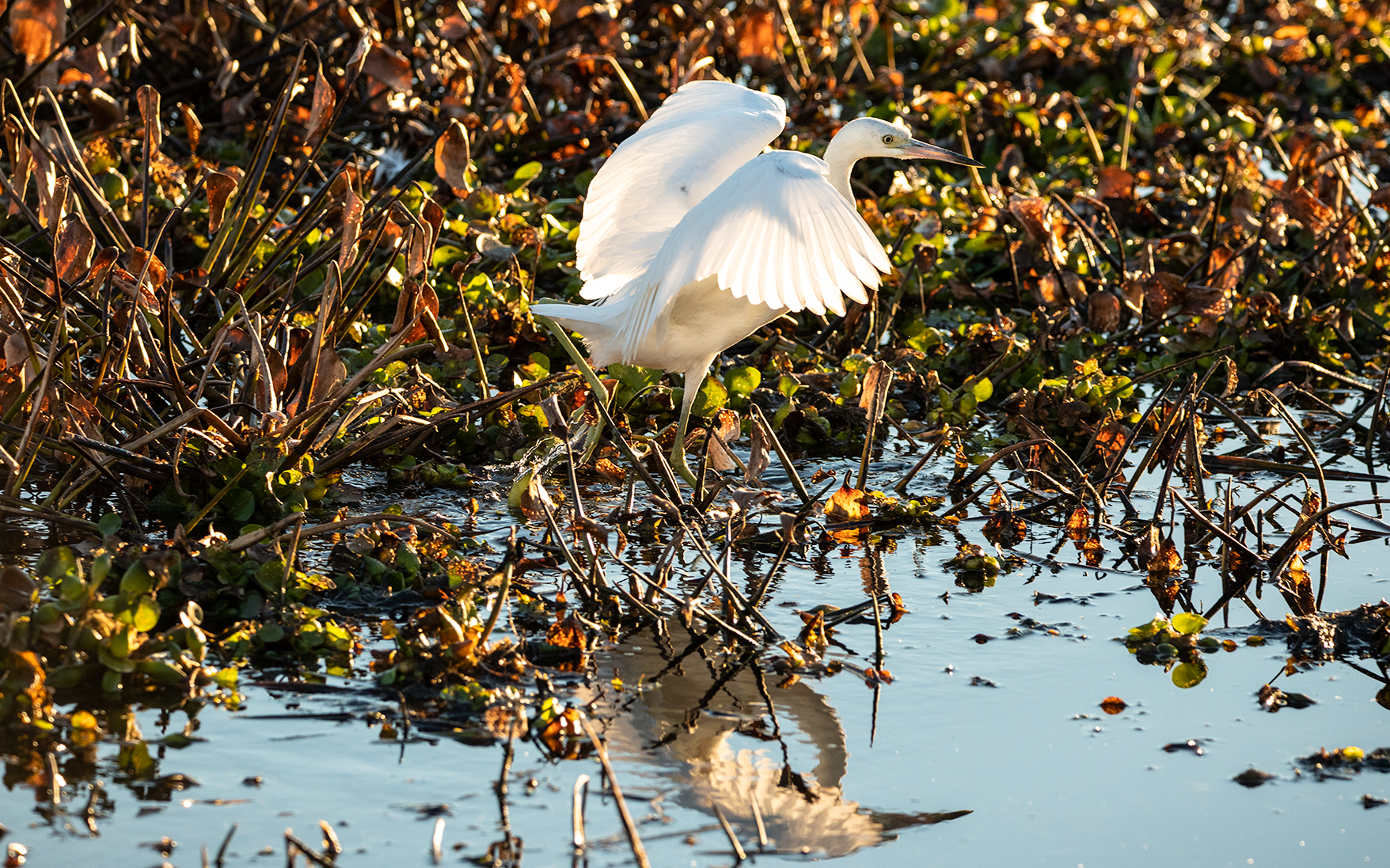
Large, lanky, long-necked white heron. Size and black legs help separate from other egrets. Widespread and fairly common across the globe. Bill color varies across range: always yellow in the Americas, black in breeding season elsewhere. Occurs in any shallow wetland, including ponds, marshes, and tidal mudflats. Slowly stalks prey in shallow water. Often seen singly, but sometimes gathers in large numbers where food is plentiful.
CULLINAN PARK . SUAGR LAND . TX . 2022
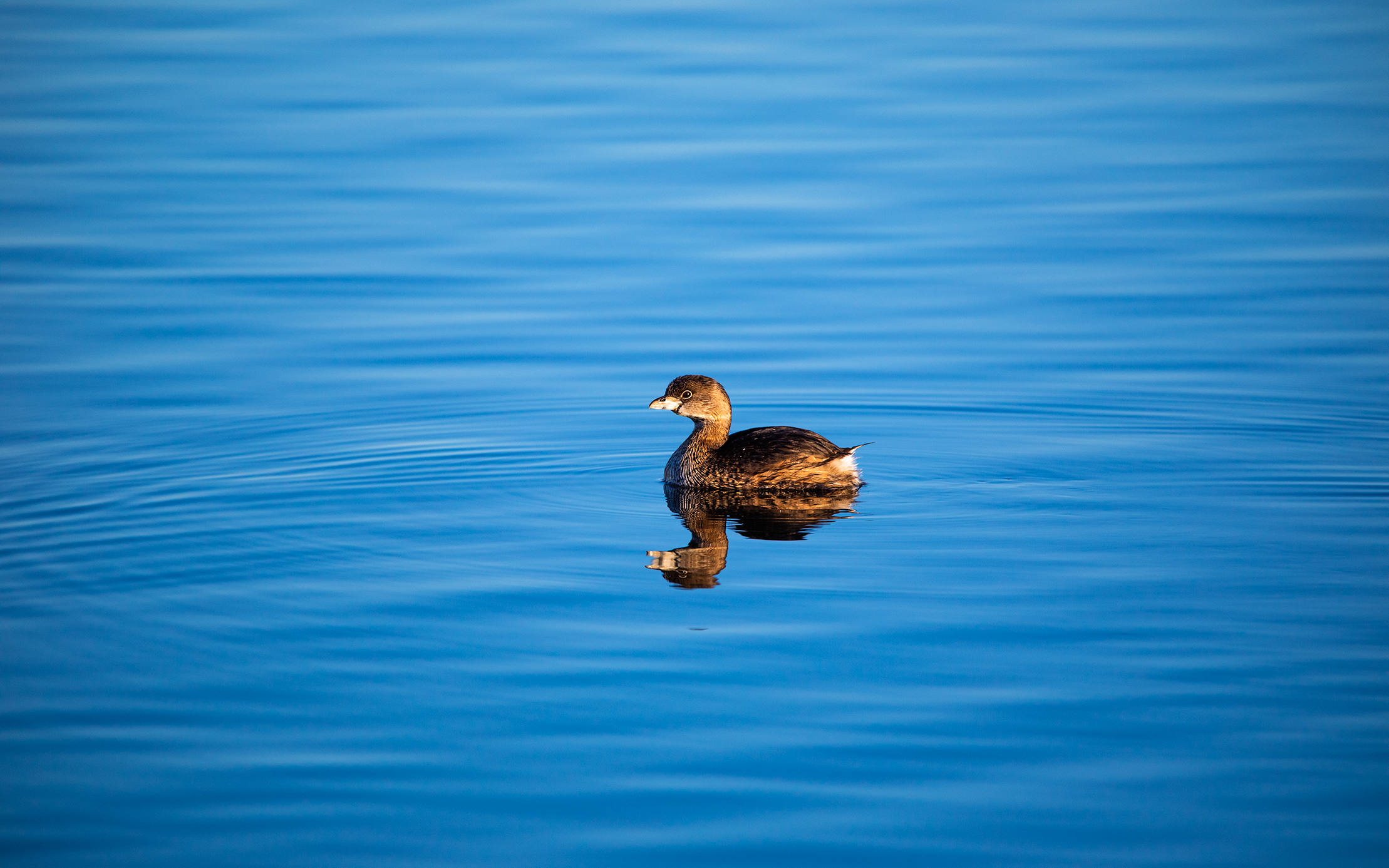
Small brown grebe with a stout bill. Note dark eyes. During breeding season, look for black ring around white bill. In winter, neck is often washed with a cinnamon tone. Juvenile has stripes on head. Fairly common and widespread throughout the Americas, where it occurs on ponds and marshes, often with emergent vegetation. Frequently dives underwater to feed on fish.
CULLINAN PARK . SUAGR LAND . TX . 2022
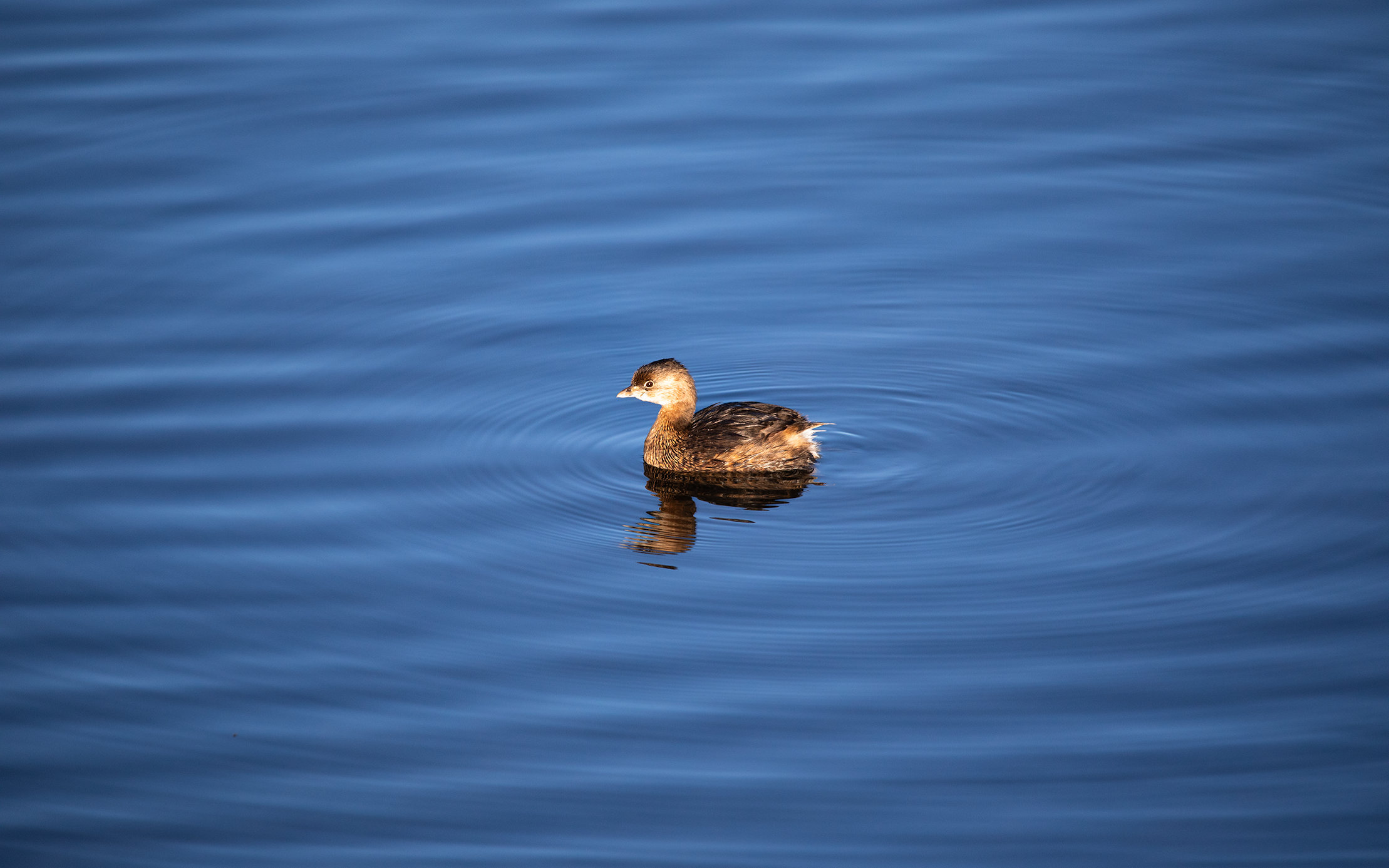
Small brown grebe with a stout bill. Note dark eyes. During breeding season, look for black ring around white bill. In winter, neck is often washed with a cinnamon tone. Juvenile has stripes on head. Fairly common and widespread throughout the Americas, where it occurs on ponds and marshes, often with emergent vegetation. Frequently dives underwater to feed on fish.
CULLINAN PARK . SUAGR LAND . TX . 2022

Small, dark heron with a blue-green back, rusty-colored neck and dark cap. Usually in a crouched position, partly concealed in vegetation, waiting patiently for prey. In flight, looks like an awkward crow with broad wings, neck tucked in, and legs extending just beyond the tail. Often vocal when flushed; gives a sharp "skeiw!"
CULLINAN PARK . SUAGR LAND . TX . 2022

Smaller than Red-tailed Hawk. Adults are beautiful with rich orange barring below and bold black-and-white checkerboard patterning on wings. Often in forested areas, where they hunt from perches. Perches on wires more frequently than Red-tailed Hawk. In flight, wings seem narrow and pushed forward compared to Red-tailed or Broad-winged Hawk; also note relatively long tail. Population in California is more richly colored (darker orange) than paler Eastern birds; while Florida birds are paler with gray head and back.
SUAGR LAND . TX . 2022
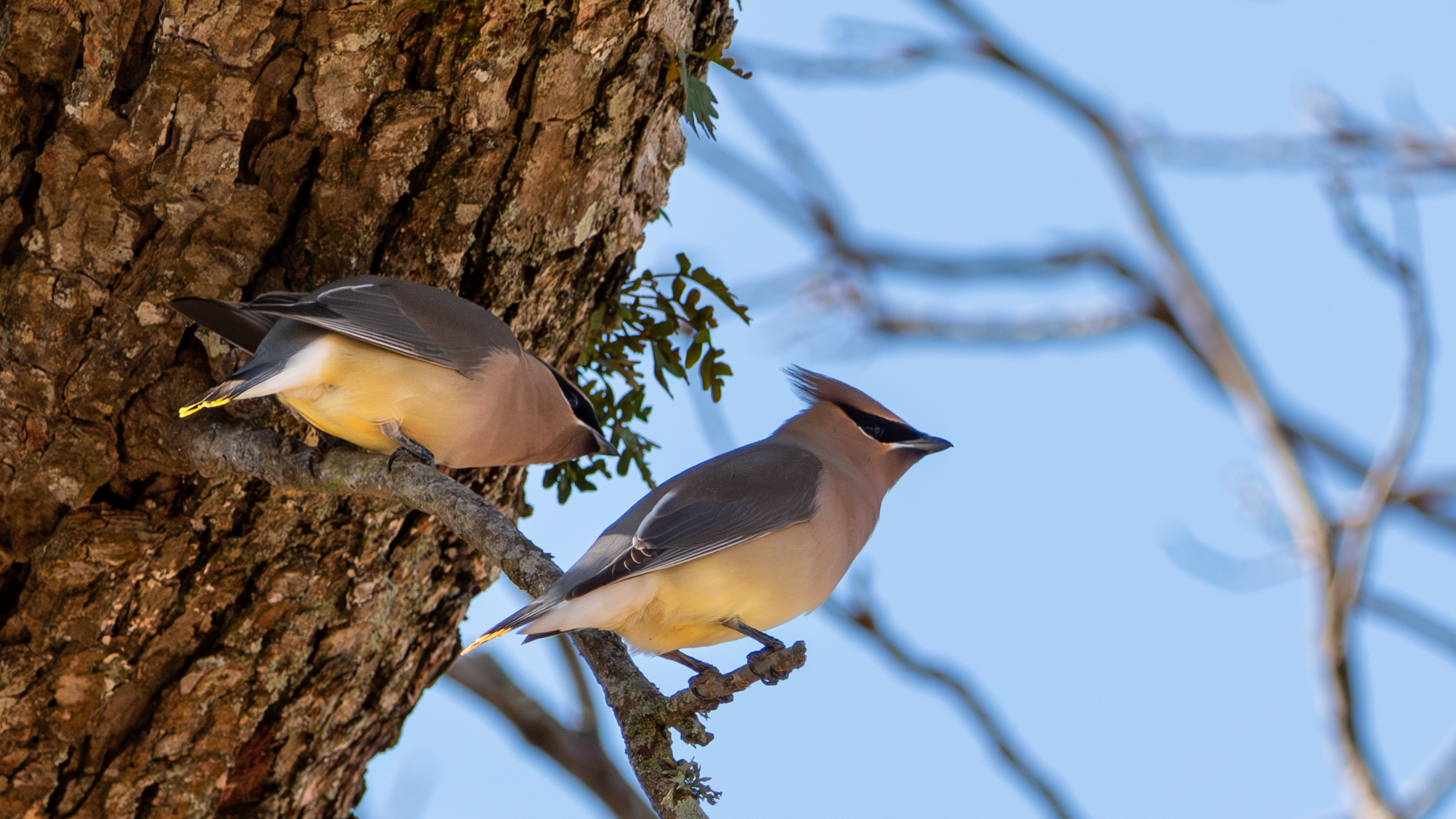
Plump, smooth-plumaged bird with distinctive thin, high-pitched call. Adults have a sleek crest, black mask, pale yellow wash on the belly, and yellow-tipped tail. Juveniles are drabber than adults, with coarse streaking on the breast and a reduced mask. Widespread and fairly common in open woodlands, orchards, and shrubby areas throughout most of North America. Winter range is variable and somewhat dependent on fruit crops; sometimes ventures as far south as Panama. Often gathers in large flocks, especially around fruiting trees. Compare with Bohemian Waxwing in the northern part of range; Cedar is smaller, browner, and has a white (not rufous) undertail.
SUAGR LAND . TX . 2024
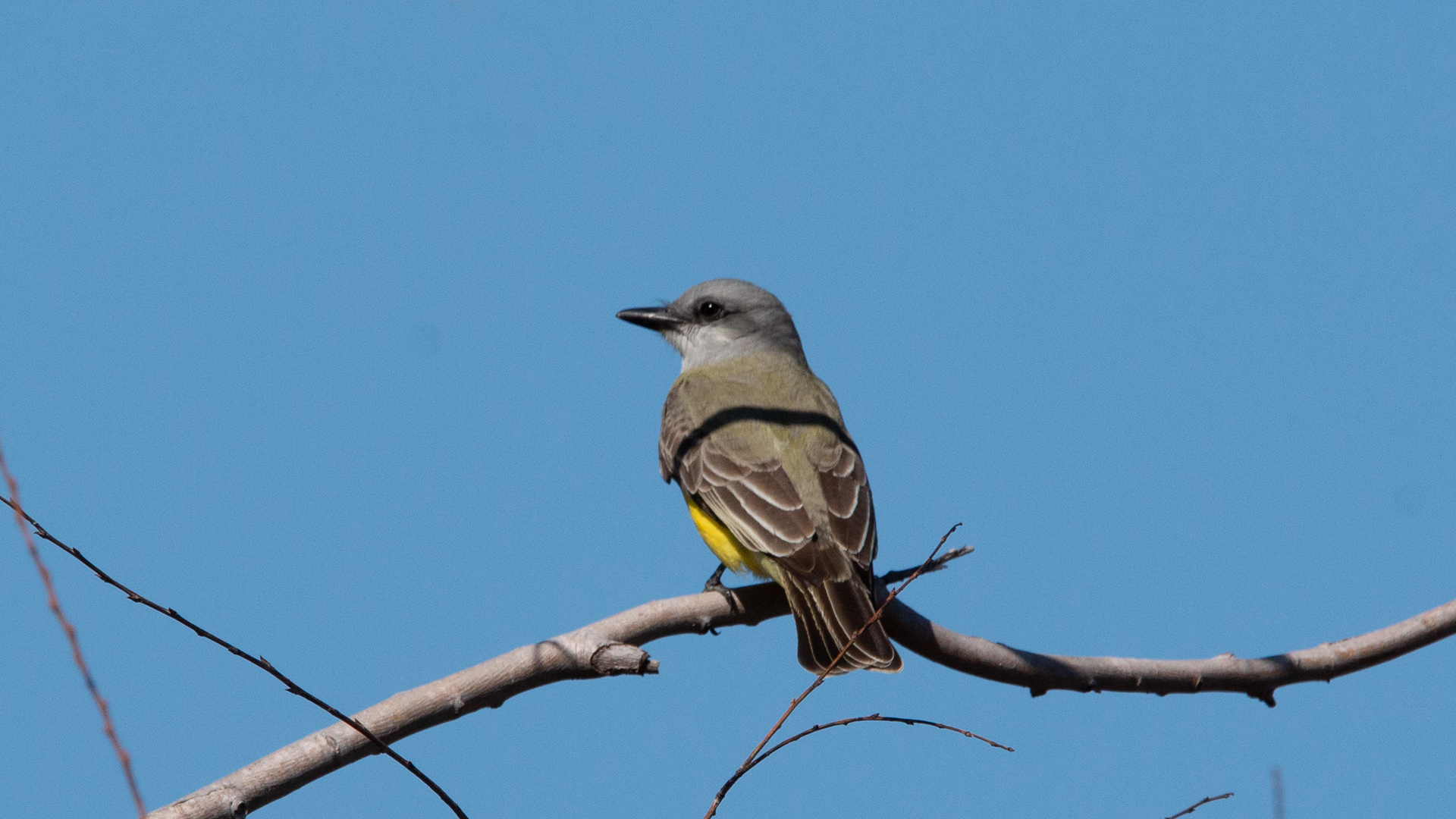
Large, ubiquitous yellow-bellied flycatcher found throughout most of Middle and South America, though tends to be uncommon at the far northern end of its range in the U.S. A classic “telephone wire” bird along roadsides and in towns. Prefers open areas with some trees and water. Most abundant in lowlands and foothills, but ventures up to over 3,000m in some parts of range. Listen for sharp, high-pitched twitters. Nearly identical to Couch’s Kingbird, which overlaps from Texas to Belize; best separated by voice. Larger and longer-billed than Western and Cassin’s Kingbird; also note paler brownish tail. Also very similar to White-throated (longer, forked tail) and Snowy-throated (dark mask) Kingbirds in some parts of South America.
SUAGR LAND . TX . 2024